
Chapter 15 Wage Determination Answer Key
Multiple Choice Questions
1.
Real wages in the United States in the long run:
AACSB: Reflective Thinking
Accessibility: Keyboard Navigation
Blooms: Remember
Difficulty: 1 Easy
Learning Objective: 15-01 Explain why labor productivity and real hourly compensation track so closely over time.
Topic: Labor, wages, and earnings
2.
The long-run trend of real wages:
AACSB: Reflective Thinking
Accessibility: Keyboard Navigation
Blooms: Remember
Difficulty: 1 Easy
Learning Objective: 15-01 Explain why labor productivity and real hourly compensation track so closely over time.
Topic: Labor, wages, and earnings

3.
If the nominal wages of carpenters rose by 5 percent in 2013 and the price level increased
by 3 percent, then the real wages of carpenters:
AACSB: Analytic
Accessibility: Keyboard Navigation
Blooms: Apply
Difficulty: 2 Medium
Learning Objective: 15-01 Explain why labor productivity and real hourly compensation track so closely over time.
Topic: Labor, wages, and earnings
4.
Over the long run, real earnings per worker can increase only at about the same rate as
the economy's rate of growth of:
AACSB: Reflective Thinking
Accessibility: Keyboard Navigation
Blooms: Understand
Difficulty: 2 Medium
Learning Objective: 15-01 Explain why labor productivity and real hourly compensation track so closely over time.
Topic: Labor, wages, and earnings
5.
Increases in the productivity of labor result partly from:
AACSB: Analytic

Accessibility: Keyboard Navigation
Blooms: Understand
Difficulty: 2 Medium
Learning Objective: 15-01 Explain why labor productivity and real hourly compensation track so closely over time.
Topic: Labor, wages, and earnings
6.
Real wages in the United States are:
AACSB: Reflective Thinking
Accessibility: Keyboard Navigation
Blooms: Remember
Difficulty: 1 Easy
Learning Objective: 15-01 Explain why labor productivity and real hourly compensation track so closely over time.
Topic: Labor, wages, and earnings
7.
According to international comparisons, which nation had the highest hourly pay in U.S.
dollar terms in 2011?
AACSB: Reflective Thinking
Accessibility: Keyboard Navigation
Blooms: Remember
Difficulty: 1 Easy
Learning Objective: 15-01 Explain why labor productivity and real hourly compensation track so closely over time.
Topic: Labor, wages, and earnings

8.
The real wage will rise if the nominal wage:
AACSB: Reflective Thinking
Accessibility: Keyboard Navigation
Blooms: Understand
Difficulty: 2 Medium
Learning Objective: 15-01 Explain why labor productivity and real hourly compensation track so closely over time.
Topic: Labor, wages, and earnings
9.
Which of the following is
correct
?
AACSB: Reflective Thinking
Accessibility: Keyboard Navigation
Blooms: Understand
Difficulty: 2 Medium
Learning Objective: 15-01 Explain why labor productivity and real hourly compensation track so closely over time.
Topic: Labor, wages, and earnings
10.
The productivity and real wages of workers in industrially advanced economies have risen
historically partly because:
AACSB: Reflective Thinking
Accessibility: Keyboard Navigation
Blooms: Remember

Difficulty: 1 Easy
Learning Objective: 15-01 Explain why labor productivity and real hourly compensation track so closely over time.
Topic: Labor, wages, and earnings
11.
If the nominal wage rises by 4 percent, and the price level rises by 7 percent, the real wage
will:
AACSB: Analytic
Accessibility: Keyboard Navigation
Blooms: Apply
Difficulty: 2 Medium
Learning Objective: 15-01 Explain why labor productivity and real hourly compensation track so closely over time.
Topic: Labor, wages, and earnings
12.
If the nominal wage rises by 6 percent, and the price level falls by 2 percent, the real wage
will:
AACSB: Analytic
Accessibility: Keyboard Navigation
Blooms: Apply
Difficulty: 2 Medium
Learning Objective: 15-01 Explain why labor productivity and real hourly compensation track so closely over time.
Topic: Labor, wages, and earnings

13.
Long-run real wages in the United States have:
AACSB: Reflective Thinking
Accessibility: Keyboard Navigation
Blooms: Remember
Difficulty: 1 Easy
Learning Objective: 15-01 Explain why labor productivity and real hourly compensation track so closely over time.
Topic: Labor, wages, and earnings
14.
Since 1960, real hourly compensation in the United States has approximately:
AACSB: Reflective Thinking
Accessibility: Keyboard Navigation
Blooms: Remember
Difficulty: 1 Easy
Learning Objective: 15-01 Explain why labor productivity and real hourly compensation track so closely over time.
Topic: Labor, wages, and earnings

15.
Marginal revenue product (MRP) of labor refers to the:
AACSB: Analytic
Accessibility: Keyboard Navigation
Blooms: Remember
Difficulty: 1 Easy
Learning Objective: 15-02 Show how wage rates and employment levels are determined in competitive labor markets.
Topic: Purely competitive labor markets
16.
Marginal resource cost refers to the:
AACSB: Analytic
Accessibility: Keyboard Navigation
Blooms: Remember
Difficulty: 1 Easy
Learning Objective: 15-02 Show how wage rates and employment levels are determined in competitive labor markets.
Topic: Purely competitive labor markets

17.
If a firm is hiring a certain type of labor under purely competitive conditions:
AACSB: Analytic
Accessibility: Keyboard Navigation
Blooms: Understand
Difficulty: 2 Medium
Learning Objective: 15-02 Show how wage rates and employment levels are determined in competitive labor markets.
Topic: Purely competitive labor markets
18.
The market supply curve for labor is upsloping because:
AACSB: Analytic
Accessibility: Keyboard Navigation
Blooms: Understand
Difficulty: 2 Medium
Learning Objective: 15-02 Show how wage rates and employment levels are determined in competitive labor markets.
Topic: Purely competitive labor markets

19.
A firm operating in a purely competitive resource market faces a resource supply curve
that is:
AACSB: Analytic
Accessibility: Keyboard Navigation
Blooms: Remember
Difficulty: 1 Easy
Learning Objective: 15-02 Show how wage rates and employment levels are determined in competitive labor markets.
Topic: Purely competitive labor markets
20.
A firm that is hiring labor in a purely competitive labor market and selling its product in a
purely competitive product market will maximize its profit by hiring labor until:
AACSB: Analytic
Accessibility: Keyboard Navigation
Blooms: Understand
Difficulty: 2 Medium
Learning Objective: 15-02 Show how wage rates and employment levels are determined in competitive labor markets.
Topic: Purely competitive labor markets

21.
A profit-maximizing firm will:
AACSB: Reflective Thinking
Accessibility: Keyboard Navigation
Blooms: Understand
Difficulty: 2 Medium
Learning Objective: 15-02 Show how wage rates and employment levels are determined in competitive labor markets.
Topic: Purely competitive labor markets
22.
A profit-maximizing firm will:
AACSB: Reflective Thinking
Accessibility: Keyboard Navigation
Blooms: Understand
Difficulty: 2 Medium
Learning Objective: 15-02 Show how wage rates and employment levels are determined in competitive labor markets.
Topic: Purely competitive labor markets
23.
A firm hiring labor in a perfectly competitive labor market faces a:
AACSB: Reflective Thinking
Accessibility: Keyboard Navigation
Blooms: Understand
Difficulty: 2 Medium

Learning Objective: 15-02 Show how wage rates and employment levels are determined in competitive labor markets.
Topic: Purely competitive labor markets
24.
Refer to the given data. If there is neither a union nor a minimum wage, we can conclude
that this firm:
AACSB: Analytic
Blooms: Apply
Difficulty: 2 Medium
Learning Objective: 15-02 Show how wage rates and employment levels are determined in competitive labor markets.
Topic: Purely competitive labor markets
Type: Table
25.
Refer to the given data. In maximizing its profit, this firm will employ:
AACSB: Analytic
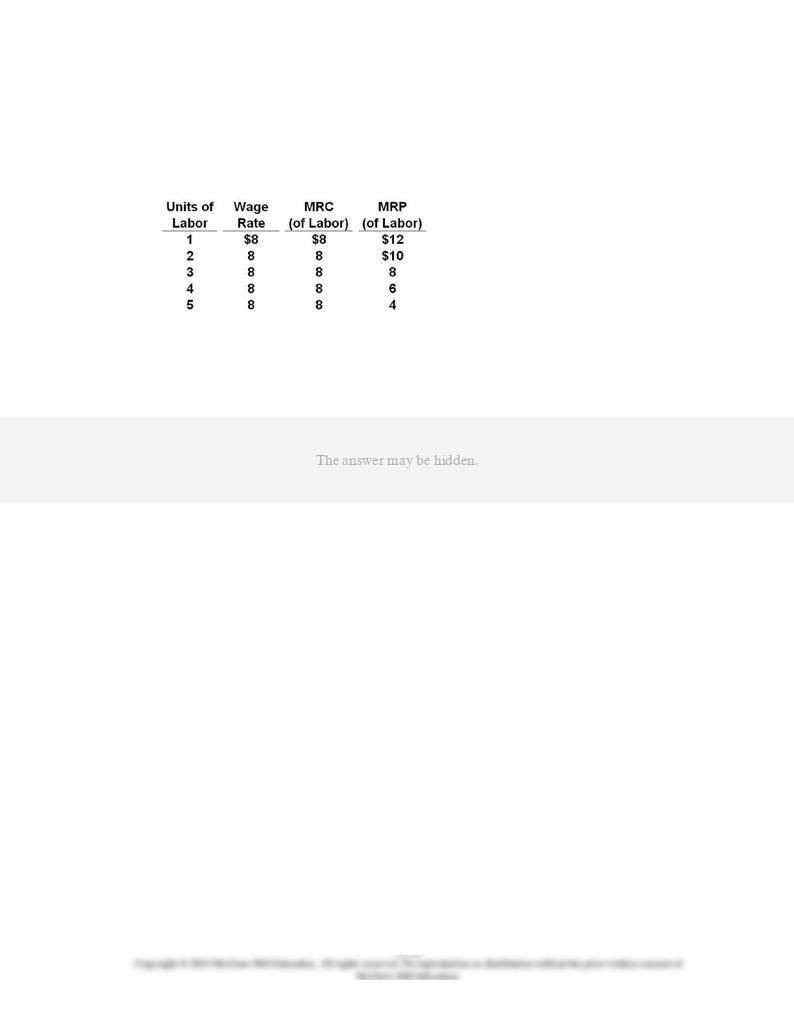
Blooms: Analyze
Difficulty: 3 Hard
Learning Objective: 15-02 Show how wage rates and employment levels are determined in competitive labor markets.
Topic: Purely competitive labor markets
Type: Table
26.
Refer to the given data. At the profit-maximizing level of employment, this firm's total labor
cost will be:
AACSB: Analytic
Blooms: Analyze
Difficulty: 3 Hard
Learning Objective: 15-02 Show how wage rates and employment levels are determined in competitive labor markets.
Topic: Purely competitive labor markets
Type: Table

27.
Refer to the given data. At the profit-maximizing level of employment, this firm's total
revenue will be:
AACSB: Analytic
Blooms: Analyze
Difficulty: 3 Hard
Learning Objective: 15-02 Show how wage rates and employment levels are determined in competitive labor markets.
Topic: Purely competitive labor markets
Type: Table
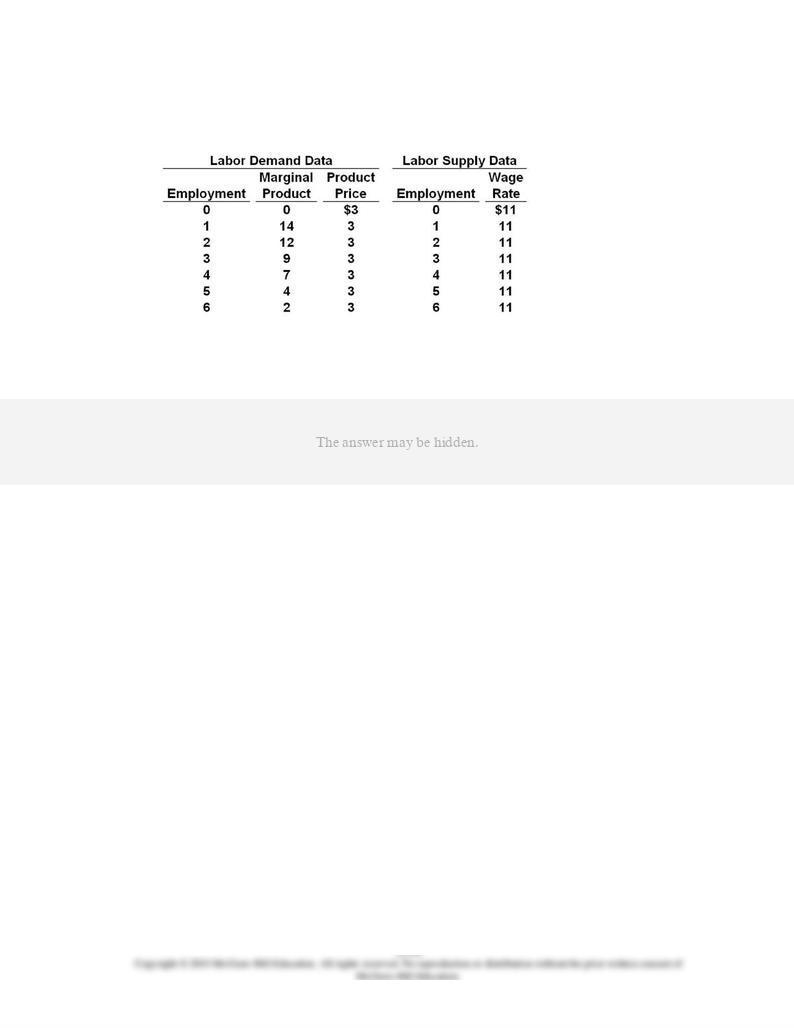
28.
Use the labor demand data on the left and the labor supply data on the right in answering
the following question:
On the basis of the given information, we:
AACSB: Analytic
Blooms: Apply
Difficulty: 2 Medium
Learning Objective: 15-02 Show how wage rates and employment levels are determined in competitive labor markets.
Topic: Purely competitive labor markets
Type: Table
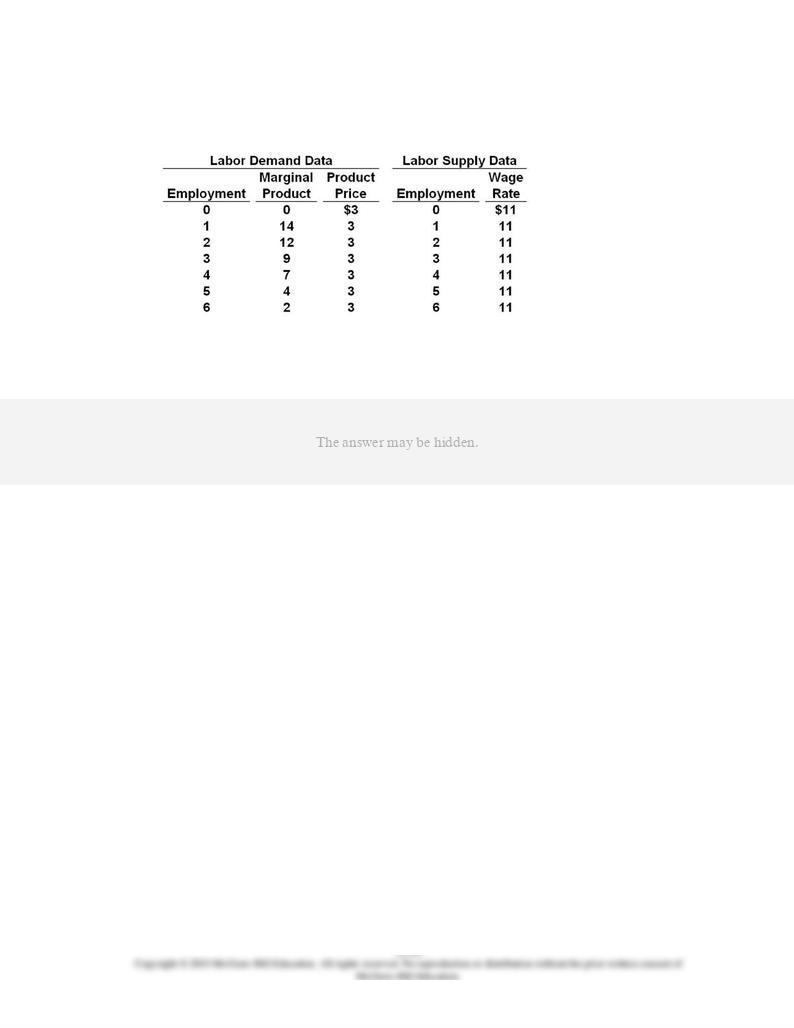
29.
Use the labor demand data on the left and the labor supply data on the right in answering
the following question:
Refer to the given data. The labor supply curve facing firms is:
AACSB: Analytic
Blooms: Apply
Difficulty: 2 Medium
Learning Objective: 15-02 Show how wage rates and employment levels are determined in competitive labor markets.
Topic: Purely competitive labor markets
Type: Table

30.
Use the labor demand data on the left and the labor supply data on the right in answering
the following question:
Refer to the given data. The firm is hiring labor:
AACSB: Analytic
Blooms: Apply
Difficulty: 2 Medium
Learning Objective: 15-02 Show how wage rates and employment levels are determined in competitive labor markets.
Topic: Purely competitive labor markets
Type: Table

31.
Use the labor demand data on the left and the labor supply data on the right in answering
the following question:
Refer to the given data. The firm will maximize profits (or minimize losses) by employing:
AACSB: Analytic
Blooms: Analyze
Difficulty: 3 Hard
Learning Objective: 15-02 Show how wage rates and employment levels are determined in competitive labor markets.
Topic: Purely competitive labor markets
Type: Table
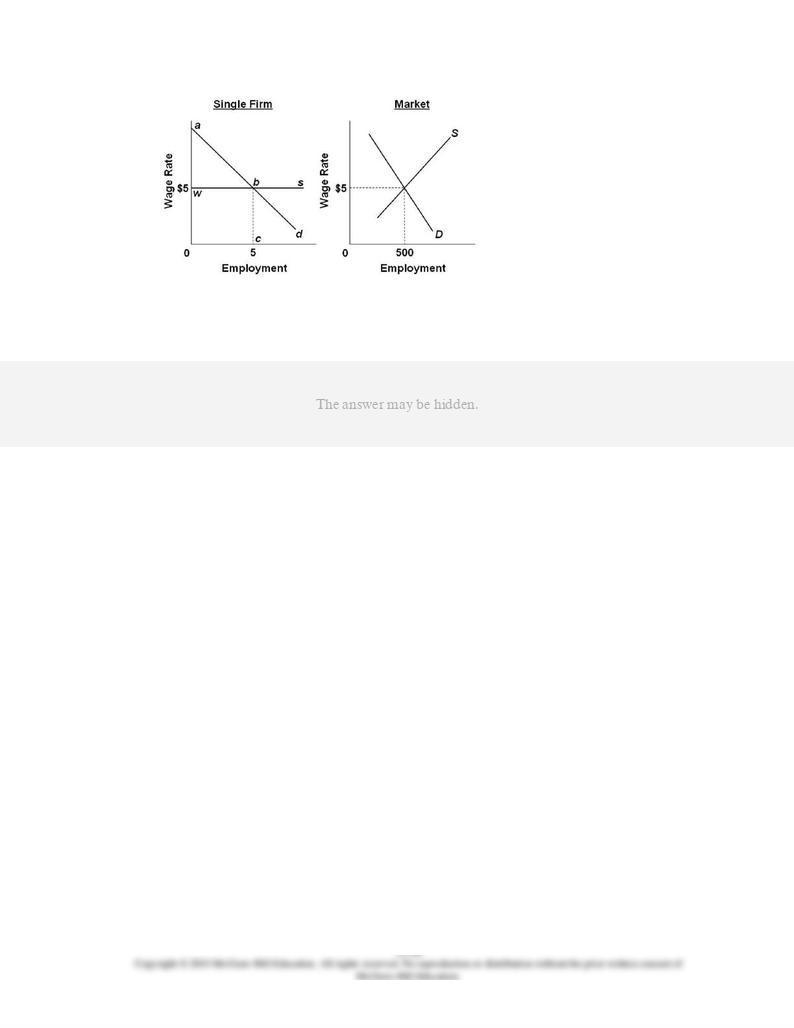
32.
Refer to the diagrams. The firm:
AACSB: Reflective Thinking
Blooms: Apply
Difficulty: 2 Medium
Learning Objective: 15-02 Show how wage rates and employment levels are determined in competitive labor markets.
Topic: Purely competitive labor markets
Type: Graph

33.
Refer to the diagrams. The firm:
AACSB: Analytic
Blooms: Apply
Difficulty: 2 Medium
Learning Objective: 15-02 Show how wage rates and employment levels are determined in competitive labor markets.
Topic: Purely competitive labor markets
Type: Graph
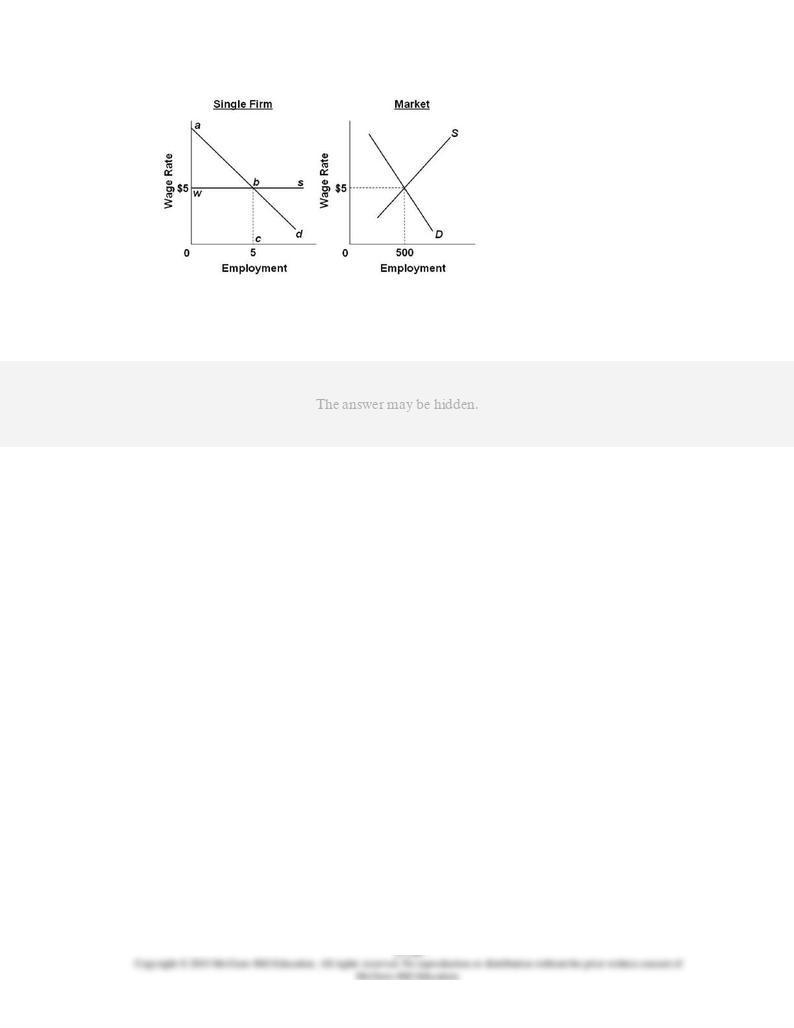
34.
Refer to the diagrams. The profit-maximizing firm's total wage cost:
AACSB: Reflective Thinking
Blooms: Analyze
Difficulty: 3 Hard
Learning Objective: 15-02 Show how wage rates and employment levels are determined in competitive labor markets.
Topic: Purely competitive labor markets
Type: Graph
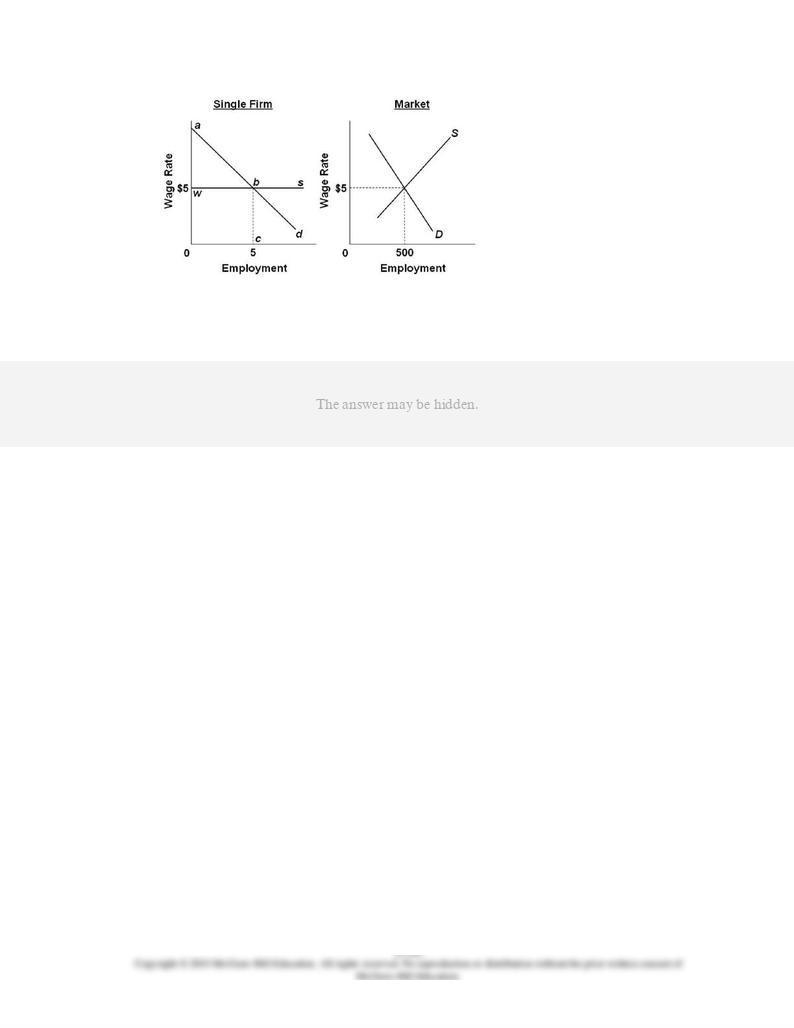
35.
Refer to the diagrams. The profit-maximizing firm's total revenue:
AACSB: Reflective Thinking
Blooms: Analyze
Difficulty: 3 Hard
Learning Objective: 15-02 Show how wage rates and employment levels are determined in competitive labor markets.
Topic: Purely competitive labor markets
Type: Graph

36.
Refer to the diagrams. At the profit-maximizing level of employment for this firm, the
amount available to pay to nonlabor resources:
AACSB: Reflective Thinking
Blooms: Analyze
Difficulty: 3 Hard
Learning Objective: 15-02 Show how wage rates and employment levels are determined in competitive labor markets.
Topic: Purely competitive labor markets
Type: Graph
37.
The
individual
firm
in a purely competitive labor market faces:
AACSB: Reflective Thinking
Accessibility: Keyboard Navigation
Blooms: Understand
Difficulty: 2 Medium
Learning Objective: 15-02 Show how wage rates and employment levels are determined in competitive labor markets.
Topic: Purely competitive labor markets

38.
Refer to the given data. This firm's product price is:
AACSB: Analytic
Blooms: Apply
Difficulty: 2 Medium
Learning Objective: 15-02 Show how wage rates and employment levels are determined in competitive labor markets.
Topic: Purely competitive labor markets
Type: Table
39.
Refer to the given data. The marginal revenue product of the second worker is:
AACSB: Analytic
Blooms: Apply
Difficulty: 2 Medium
Learning Objective: 15-02 Show how wage rates and employment levels are determined in competitive labor markets.
Topic: Purely competitive labor markets
Type: Table

40.
Refer to the given data. The marginal revenue product of the fourth worker is:
AACSB: Analytic
Blooms: Apply
Difficulty: 2 Medium
Learning Objective: 15-02 Show how wage rates and employment levels are determined in competitive labor markets.
Topic: Purely competitive labor markets
Type: Table
41.
Refer to the given data. We can conclude from the information given that this firm is a:
AACSB: Analytic
Blooms: Analyze
Difficulty: 3 Hard
Learning Objective: 15-02 Show how wage rates and employment levels are determined in competitive labor markets.
Topic: Purely competitive labor markets
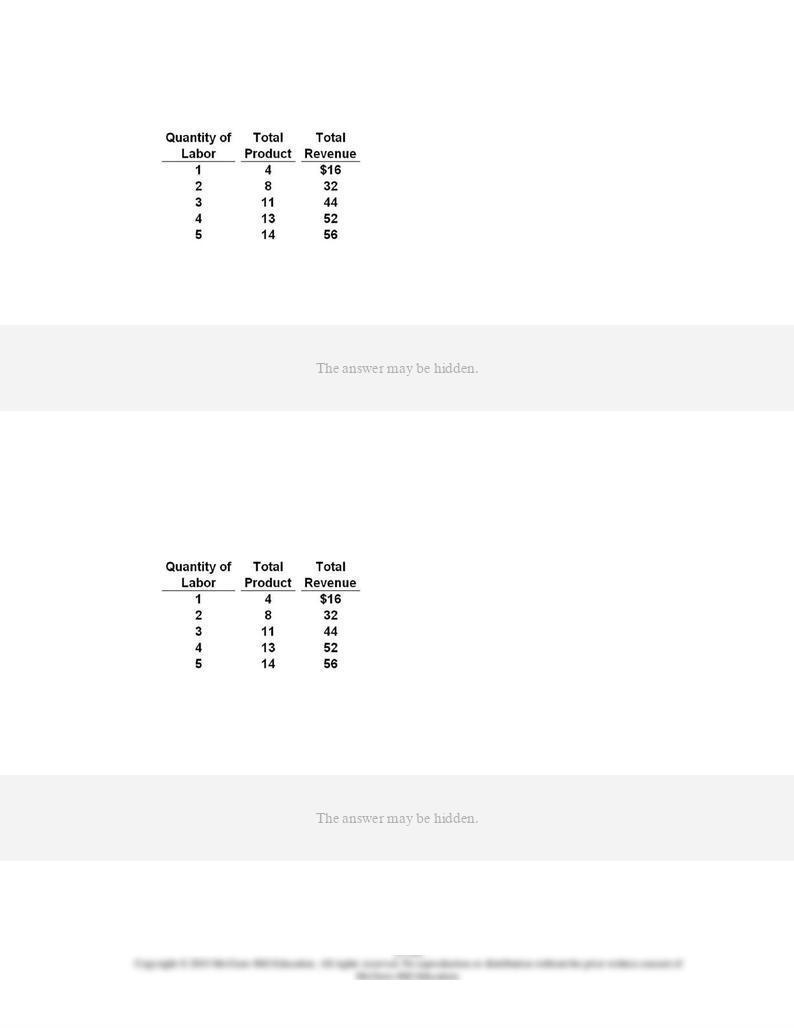
Type: Table
42.
Refer to the given data. If the market wage rate is $8, this firm will employ:
AACSB: Analytic
Blooms: Analyze
Difficulty: 3 Hard
Learning Objective: 15-02 Show how wage rates and employment levels are determined in competitive labor markets.
Topic: Purely competitive labor markets
Type: Table
43.
Refer to the given data. If the market wage rate is $8 and the firm hires its profit-
maximizing number of workers, the firm's total wage bill (payment) will be:
AACSB: Analytic
Blooms: Analyze
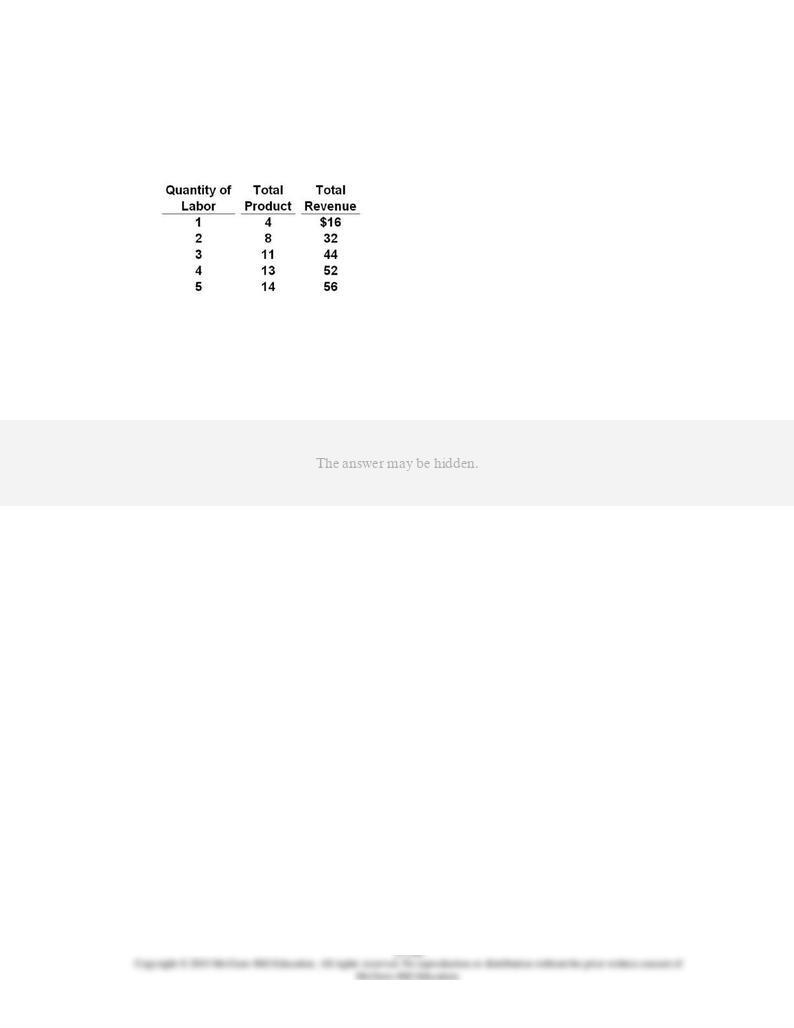
Difficulty: 3 Hard
Learning Objective: 15-02 Show how wage rates and employment levels are determined in competitive labor markets.
Topic: Purely competitive labor markets
Type: Table
44.
Refer to the given data. If the market wage rate is $8 and the firm hires its profit-
maximizing number of workers, the firm's total revenue will exceed its total wage payment
by:
AACSB: Analytic
Blooms: Analyze
Difficulty: 3 Hard
Learning Objective: 15-02 Show how wage rates and employment levels are determined in competitive labor markets.
Topic: Purely competitive labor markets
Type: Table
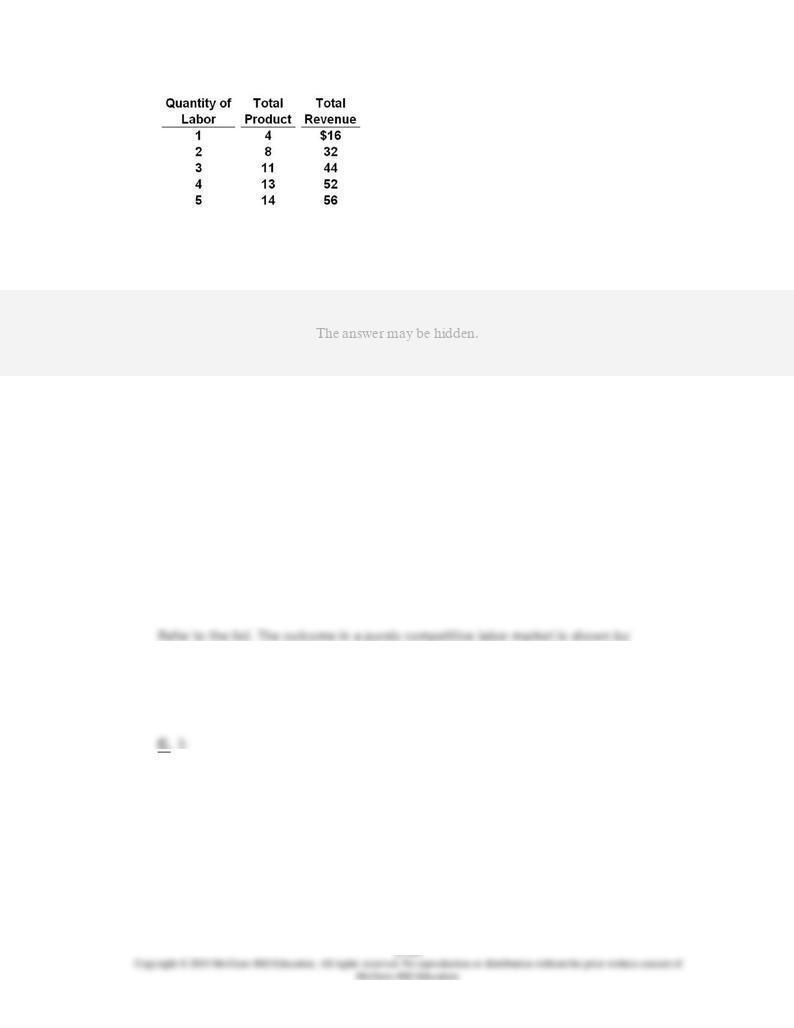
45.
Refer to the given data. If this firm can hire as few or many workers as it wants at $8, it is:
AACSB: Analytic
Blooms: Apply
Difficulty: 2 Medium
Learning Objective: 15-02 Show how wage rates and employment levels are determined in competitive labor markets.
Topic: Purely competitive labor markets
Type: Table
46.
1.
W
< MRP;
W
< MRC
2.
W
= MRP;
W
< MRC
3.
W
= MRP;
W
= MRC
4.
W
> MRP;
W
> MRC
A.
1.
B.
2.
D.
4.
AACSB: Reflective Thinking
Accessibility: Keyboard Navigation
Blooms: Remember
Difficulty: 1 Easy
Learning Objective: 15-03 Demonstrate how monopsony (a market with a single employer) can reduce wages below
competitive levels.
Topic: Monopsony model

47.
1.
W
< MRP;
W
< MRC
2.
W
= MRP;
W
< MRC
3.
W
= MRP;
W
= MRC
4.
W
> MRP;
W
> MRC
B.
2.
C.
3.
D.
4.
AACSB: Reflective Thinking
Accessibility: Keyboard Navigation
Blooms: Remember
Difficulty: 1 Easy
Learning Objective: 15-03 Demonstrate how monopsony (a market with a single employer) can reduce wages below
competitive levels.
Topic: Monopsony model
48.
The labor supply curve facing a purely competitive employer is __________, whereas the
labor supply curve facing a monopsonist is ___________.
AACSB: Reflective Thinking
Accessibility: Keyboard Navigation
Blooms: Understand
Difficulty: 2 Medium
Learning Objective: 15-03 Demonstrate how monopsony (a market with a single employer) can reduce wages below
competitive levels.
Topic: Monopsony model

49.
Use the resource demand data shown on the left and the resource supply data on the right
in answering the following question:
Refer to the given data. How many workers will this profit-maximizing firm choose to
employ?
A.
6.
B.
5.
C.
4.
AACSB: Analytic
Blooms: Analyze
Difficulty: 3 Hard
Learning Objective: 15-03 Demonstrate how monopsony (a market with a single employer) can reduce wages below
competitive levels.
Topic: Monopsony model
Type: Table
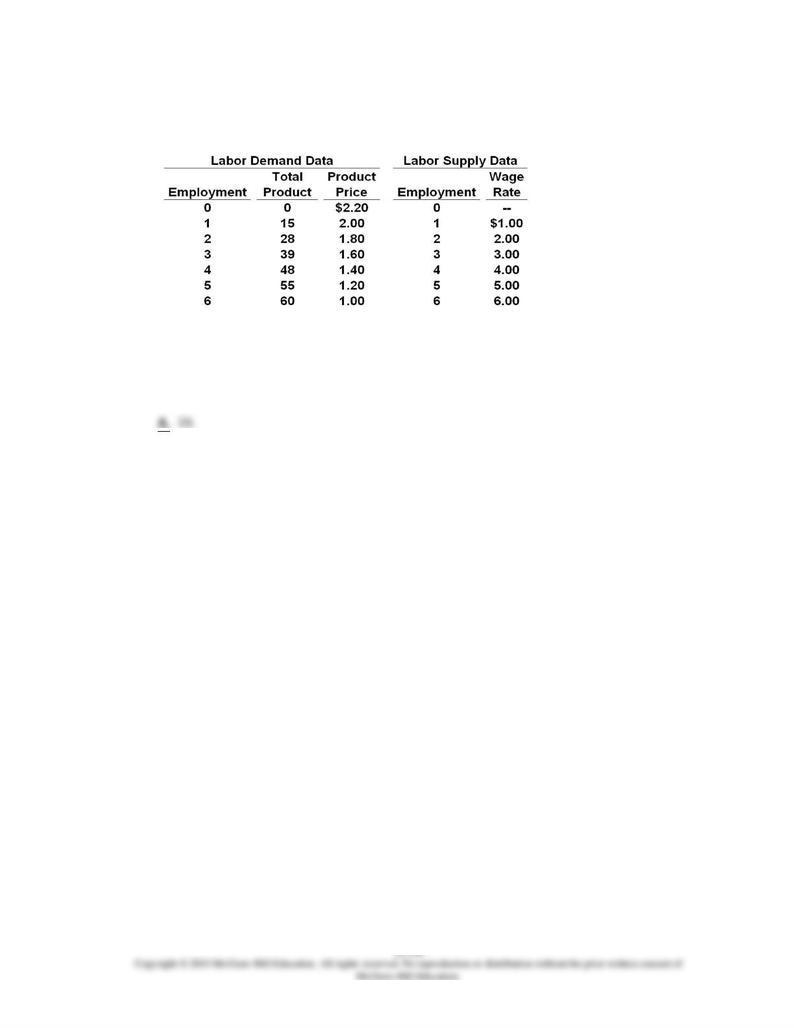
50.
Use the resource demand data shown on the left and the resource supply data on the right
in answering the following question:
Refer to the given data. How many units of output will this profit-maximizing firm
produce?
B.
48.
C.
55.
D.
60.
AACSB: Analytic
Blooms: Analyze
Difficulty: 3 Hard
Learning Objective: 15-03 Demonstrate how monopsony (a market with a single employer) can reduce wages below
competitive levels.
Topic: Monopsony model
Type: Table
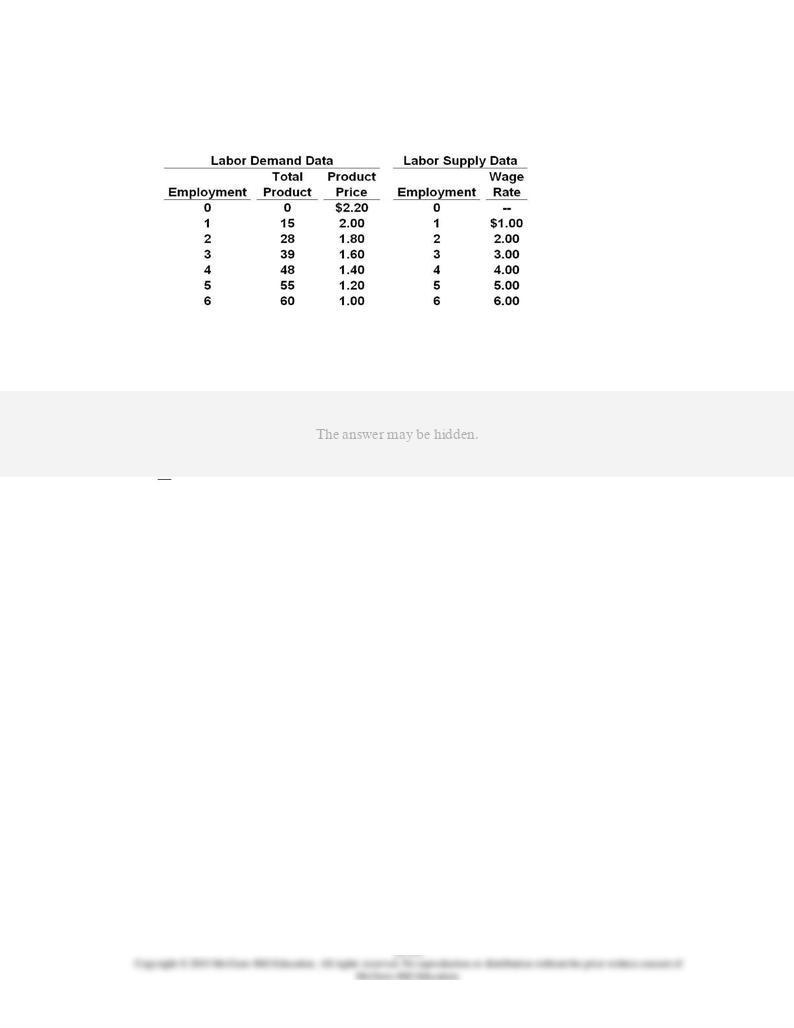
51.
Use the resource demand data shown on the left and the resource supply data on the right
in answering the following question:
Refer to the given data. What will be the profit-maximizing wage rate?
AACSB: Analytic
Blooms: Analyze
Difficulty: 3 Hard
Learning Objective: 15-03 Demonstrate how monopsony (a market with a single employer) can reduce wages below
competitive levels.
Topic: Monopsony model
Type: Table
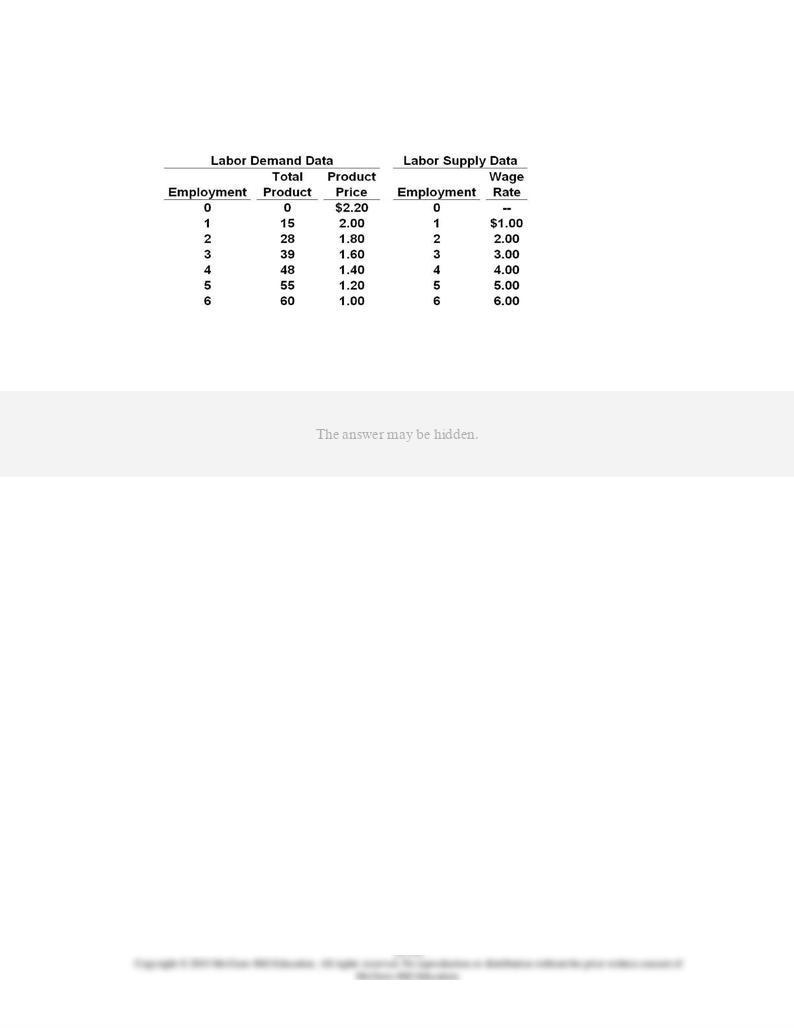
52.
Use the resource demand data shown on the left and the resource supply data on the right
in answering the following question:
Refer to the given data. What will be the profit-maximizing selling price of the product?
AACSB: Analytic
Blooms: Analyze
Difficulty: 3 Hard
Learning Objective: 15-03 Demonstrate how monopsony (a market with a single employer) can reduce wages below
competitive levels.
Topic: Monopsony model
Type: Table
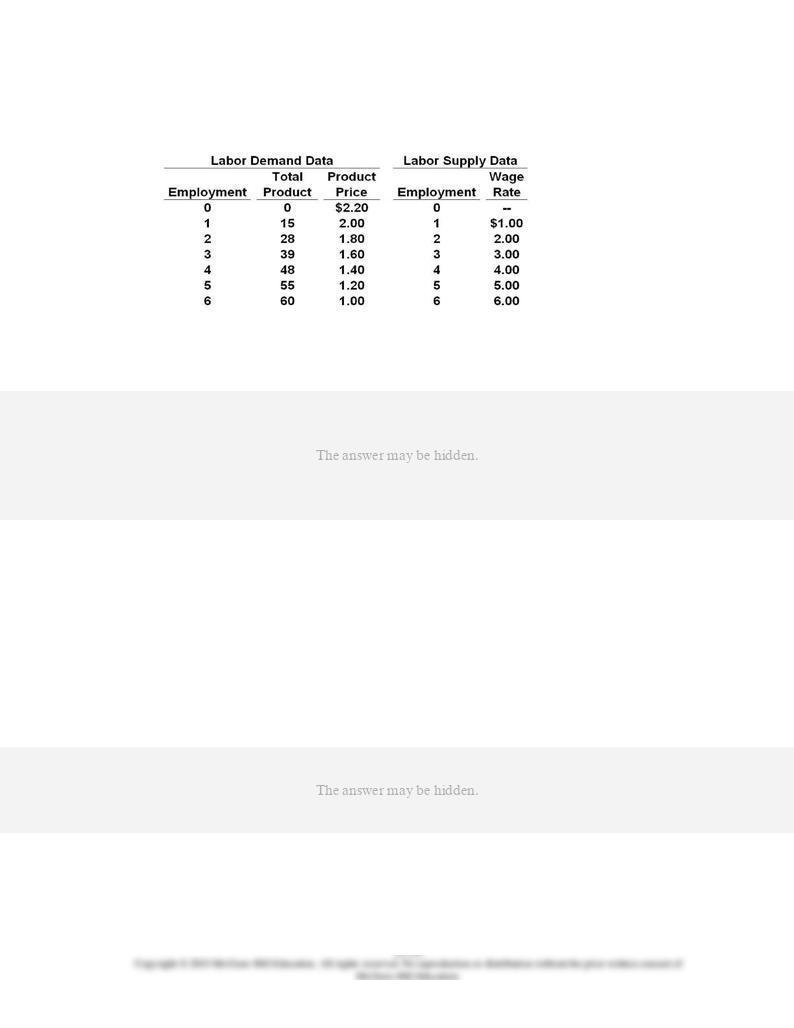
53.
Use the resource demand data shown on the left and the resource supply data on the right
in answering the following question:
Refer to the given data. We can conclude that:
AACSB: Analytic
Blooms: Analyze
Difficulty: 3 Hard
Learning Objective: 15-03 Demonstrate how monopsony (a market with a single employer) can reduce wages below
competitive levels.
Topic: Monopsony model
Type: Table
54.
The economic term for a firm that is the sole buyer in a market is:
AACSB: Analytic
Accessibility: Keyboard Navigation
Blooms: Remember
Difficulty: 1 Easy

Learning Objective: 15-03 Demonstrate how monopsony (a market with a single employer) can reduce wages below
competitive levels.
Topic: Monopsony model
55.
In a monopsonistic labor market, the employer will maximize profits by employing workers
up to that point at which:
AACSB: Reflective Thinking
Accessibility: Keyboard Navigation
Blooms: Understand
Difficulty: 2 Medium
Learning Objective: 15-03 Demonstrate how monopsony (a market with a single employer) can reduce wages below
competitive levels.
Topic: Monopsony model
56.
A firm can hire six workers at a wage rate of $8 per hour but must pay $9 per hour to all of
its employees to attract a seventh worker. The marginal wage cost of the seventh worker
is:
AACSB: Analytic
Accessibility: Keyboard Navigation
Blooms: Apply
Difficulty: 2 Medium
Learning Objective: 15-03 Demonstrate how monopsony (a market with a single employer) can reduce wages below
competitive levels.
Topic: Monopsony model

57.
Suppose the MRP of a firm's 12th worker is $22 and the worker's marginal wage cost is
$16. We can say with certainty that the firm:
AACSB: Analytic
Accessibility: Keyboard Navigation
Blooms: Apply
Difficulty: 2 Medium
Learning Objective: 15-03 Demonstrate how monopsony (a market with a single employer) can reduce wages below
competitive levels.
Topic: Monopsony model
58.
In monopsony:
AACSB: Analytic
Accessibility: Keyboard Navigation
Blooms: Understand
Difficulty: 2 Medium
Learning Objective: 15-03 Demonstrate how monopsony (a market with a single employer) can reduce wages below
competitive levels.
Topic: Monopsony model

59.
Which of the following is most likely to be an example of monopsony?
AACSB: Reflective Thinking
Accessibility: Keyboard Navigation
Blooms: Apply
Difficulty: 2 Medium
Learning Objective: 15-03 Demonstrate how monopsony (a market with a single employer) can reduce wages below
competitive levels.
Topic: Monopsony model
60.
If a firm faces an upsloping labor supply curve (and there is no union or minimum wage),
its:
AACSB: Reflective Thinking
Accessibility: Keyboard Navigation
Blooms: Understand
Difficulty: 2 Medium
Learning Objective: 15-03 Demonstrate how monopsony (a market with a single employer) can reduce wages below
competitive levels.
Topic: Monopsony model

61.
A monopsonist's wage cost in hiring an additional worker is the:
AACSB: Analytic
Accessibility: Keyboard Navigation
Blooms: Remember
Difficulty: 1 Easy
Learning Objective: 15-03 Demonstrate how monopsony (a market with a single employer) can reduce wages below
competitive levels.
Topic: Monopsony model
62.
A monopsonistic employer:
AACSB: Analytic
Accessibility: Keyboard Navigation
Blooms: Remember
Difficulty: 1 Easy
Learning Objective: 15-03 Demonstrate how monopsony (a market with a single employer) can reduce wages below
competitive levels.
Topic: Monopsony model

63.
Other things equal, the monopsonistic employer will pay a:
AACSB: Reflective Thinking
Accessibility: Keyboard Navigation
Blooms: Understand
Difficulty: 2 Medium
Learning Objective: 15-03 Demonstrate how monopsony (a market with a single employer) can reduce wages below
competitive levels.
Topic: Monopsony model
64.
Assume the Ajax Mining Company hires 80 percent of the nonunion labor force of Mother
Lode, New Mexico. Also, suppose that this labor force is highly immobile. Economists
would describe this employer as a:
AACSB: Reflective Thinking
Accessibility: Keyboard Navigation
Blooms: Apply
Difficulty: 2 Medium
Learning Objective: 15-03 Demonstrate how monopsony (a market with a single employer) can reduce wages below
competitive levels.
Topic: Monopsony model

65.
A monopsonistic employer in an unorganized (nonunion) labor market will:
AACSB: Reflective Thinking
Accessibility: Keyboard Navigation
Blooms: Understand
Difficulty: 2 Medium
Learning Objective: 15-03 Demonstrate how monopsony (a market with a single employer) can reduce wages below
competitive levels.
Topic: Monopsony model
66.
As compared to a purely competitive labor market, in a nonunionized monopsonistic labor
market, wages:
AACSB: Reflective Thinking
Accessibility: Keyboard Navigation
Blooms: Understand
Difficulty: 2 Medium
Learning Objective: 15-03 Demonstrate how monopsony (a market with a single employer) can reduce wages below
competitive levels.
Topic: Monopsony model

67.
"Player drafts" of professional athletes:
AACSB: Reflective Thinking
Accessibility: Keyboard Navigation
Blooms: Apply
Difficulty: 2 Medium
Learning Objective: 15-03 Demonstrate how monopsony (a market with a single employer) can reduce wages below
competitive levels.
Topic: Monopsony model
68.
Which of the following is
not
correct?
AACSB: Reflective Thinking
Accessibility: Keyboard Navigation
Blooms: Understand
Difficulty: 2 Medium
Learning Objective: 15-03 Demonstrate how monopsony (a market with a single employer) can reduce wages below
competitive levels.
Topic: Monopsony model

69.
A monopsonistic employer's marginal resource (labor) cost curve:
AACSB: Analytic
Accessibility: Keyboard Navigation
Blooms: Understand
Difficulty: 2 Medium
Learning Objective: 15-03 Demonstrate how monopsony (a market with a single employer) can reduce wages below
competitive levels.
Topic: Monopsony model
70.
The critical feature of a monopsonistic labor market is that the employer:
AACSB: Analytic
Accessibility: Keyboard Navigation
Blooms: Understand
Difficulty: 2 Medium
Learning Objective: 15-03 Demonstrate how monopsony (a market with a single employer) can reduce wages below
competitive levels.
Topic: Monopsony model

71.
If a firm is a monopsonist in the hiring of both labor and capital, it will obtain the profit-
maximizing quantities of labor and capital when:
AACSB: Reflective Thinking
Accessibility: Keyboard Navigation
Blooms: Understand
Difficulty: 2 Medium
Learning Objective: 15-03 Demonstrate how monopsony (a market with a single employer) can reduce wages below
competitive levels.
Topic: Monopsony model
72.
If a firm is hiring variable resources D and F in imperfectly competitive input markets, it
will maximize profits by employing D and F in such quantifies that:
AACSB: Reflective Thinking
Accessibility: Keyboard Navigation
Blooms: Understand
Difficulty: 2 Medium
Learning Objective: 15-03 Demonstrate how monopsony (a market with a single employer) can reduce wages below
competitive levels.
Topic: Monopsony model
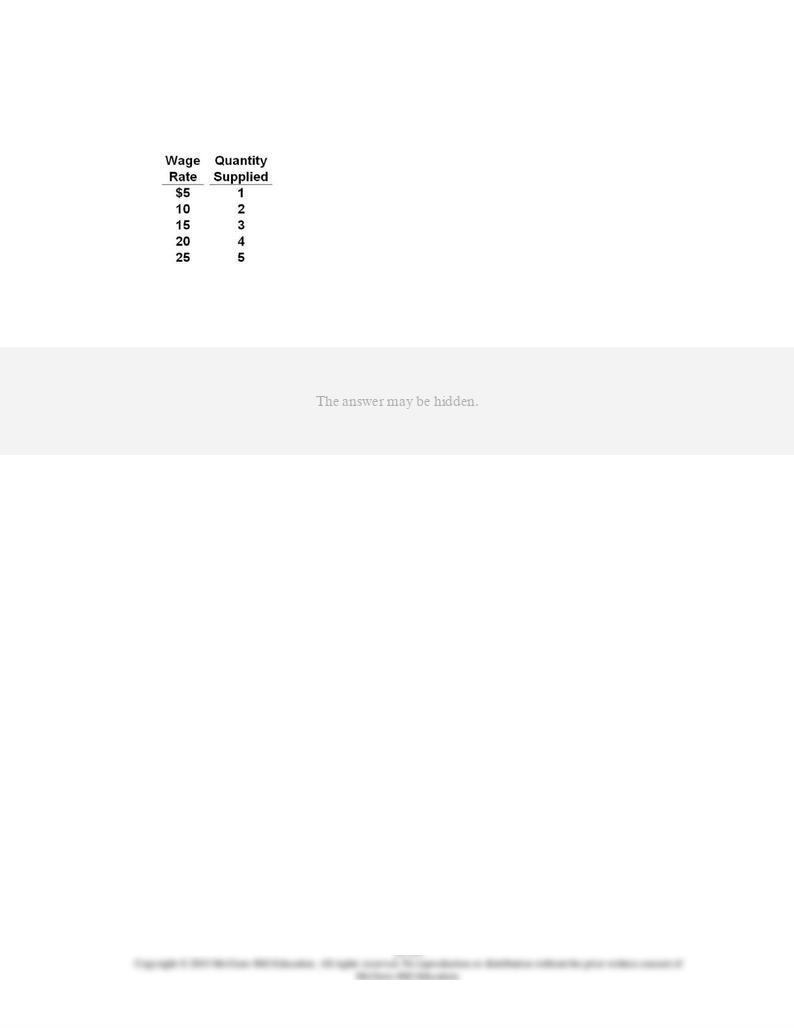
73.
Answer the question on the basis of the following supply information facing a single firm in
a particular labor market:
Refer to the given information. This labor supply curve demonstrates that:
AACSB: Analytic
Blooms: Apply
Difficulty: 2 Medium
Learning Objective: 15-03 Demonstrate how monopsony (a market with a single employer) can reduce wages below
competitive levels.
Topic: Monopsony model
Type: Table
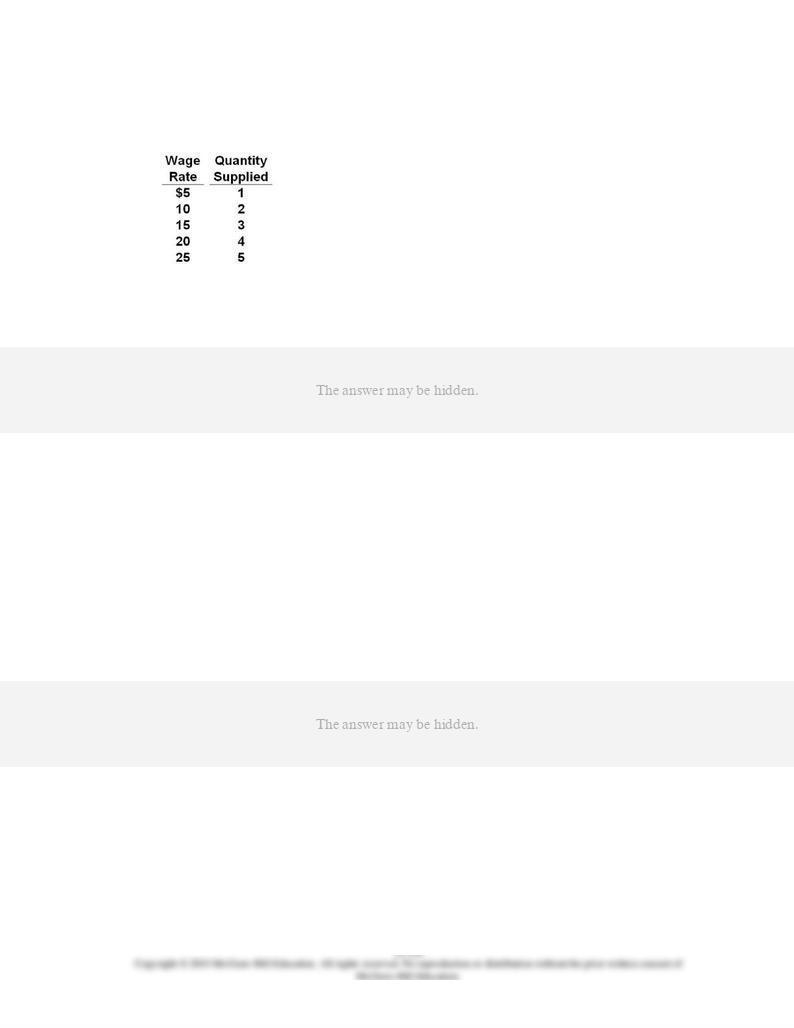
74.
Answer the question on the basis of the following supply information facing a single firm in
a particular labor market:
Refer to the given information. The marginal resource (labor) cost of the third worker is:
AACSB: Analytic
Blooms: Apply
Difficulty: 2 Medium
Learning Objective: 15-03 Demonstrate how monopsony (a market with a single employer) can reduce wages below
competitive levels.
Topic: Monopsony model
Type: Table
75.
Empirical studies suggest that, other things equal, the smaller the number of hospitals in a
city, the lower are nurses' wages. This is evidence that:
AACSB: Reflective Thinking
Accessibility: Keyboard Navigation
Blooms: Apply
Difficulty: 2 Medium
Learning Objective: 15-03 Demonstrate how monopsony (a market with a single employer) can reduce wages below
competitive levels.
Topic: Monopsony model

76.
If the diagram were relevant to an individual firm, we could conclude that the firm is:
AACSB: Reflective Thinking
Blooms: Apply
Difficulty: 2 Medium
Learning Objective: 15-03 Demonstrate how monopsony (a market with a single employer) can reduce wages below
competitive levels.
Topic: Monopsony model
Type: Graph
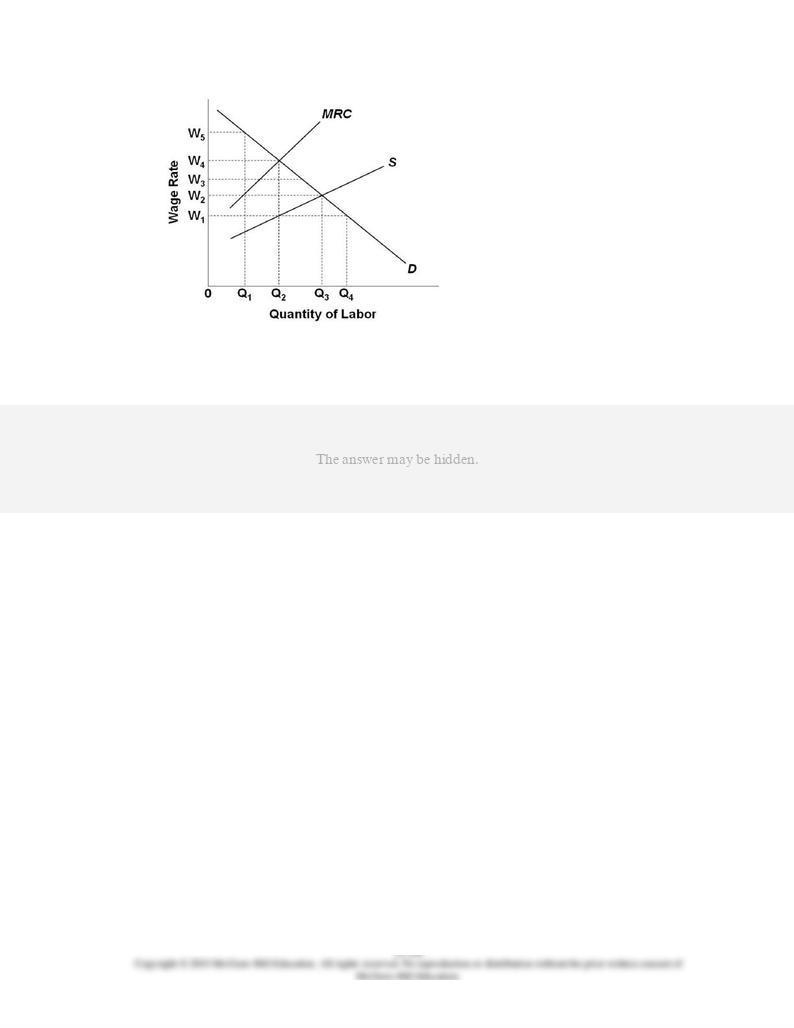
77.
Refer to the diagram. The MRC curve lies above the labor supply curve because:
AACSB: Reflective Thinking
Blooms: Apply
Difficulty: 2 Medium
Learning Objective: 15-03 Demonstrate how monopsony (a market with a single employer) can reduce wages below
competitive levels.
Topic: Monopsony model
Type: Graph
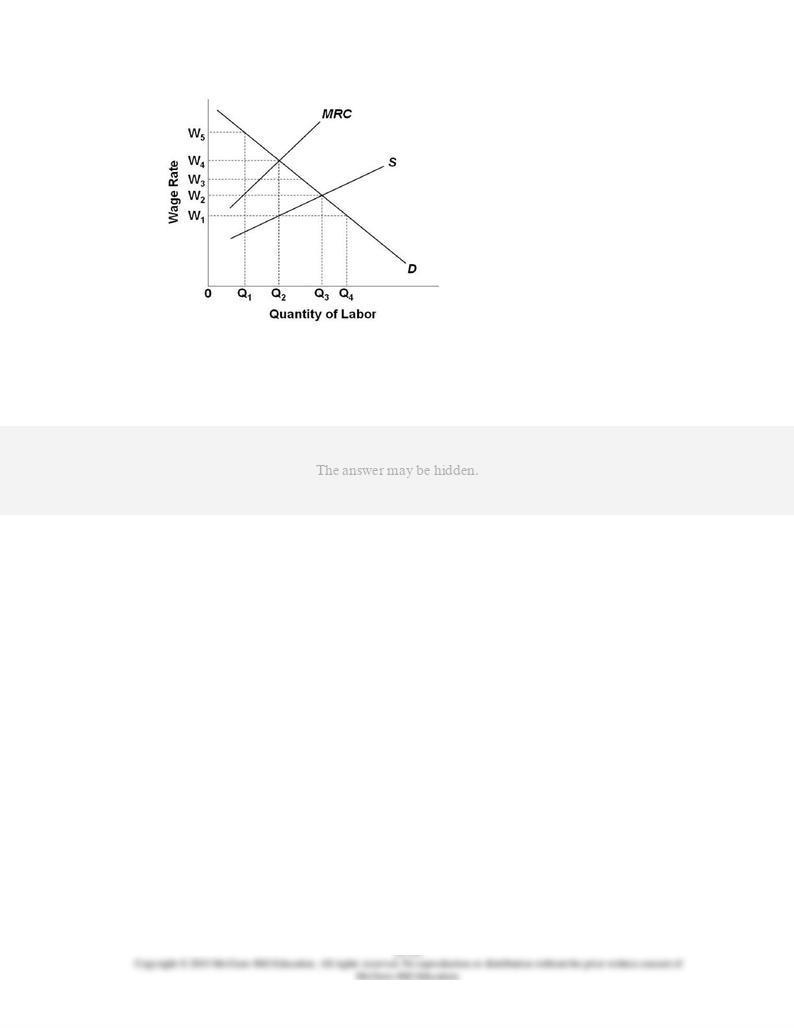
78.
Refer to the diagram. Assuming no union or relevant minimum wage, the firm represented
will hire:
AACSB: Reflective Thinking
Blooms: Analyze
Difficulty: 3 Hard
Learning Objective: 15-03 Demonstrate how monopsony (a market with a single employer) can reduce wages below
competitive levels.
Topic: Monopsony model
Type: Graph

79.
1 and
4.
4.
1.
AACSB: Reflective Thinking
Blooms: Analyze
Difficulty: 3 Hard
Learning Objective: 15-03 Demonstrate how monopsony (a market with a single employer) can reduce wages below
competitive levels.
Topic: Monopsony model
Type: Graph
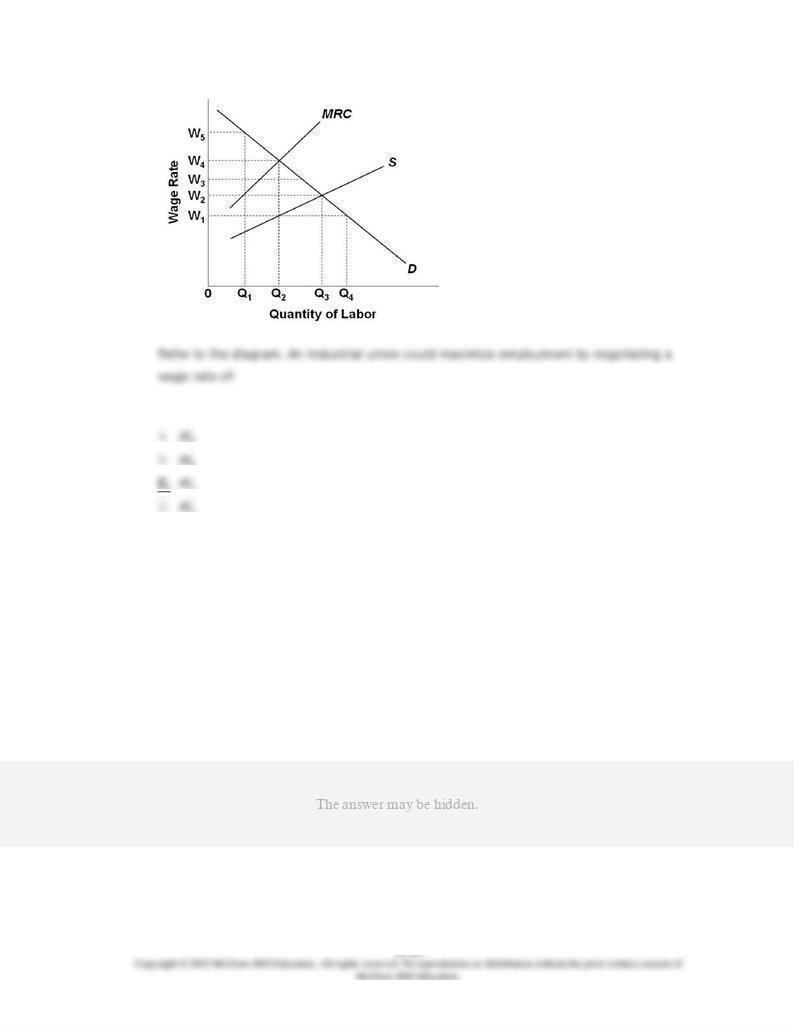
80.
4.
3.
2.
1.
AACSB: Reflective Thinking
Blooms: Analyze
Difficulty: 3 Hard
Learning Objective: 15-03 Demonstrate how monopsony (a market with a single employer) can reduce wages below
competitive levels.
Topic: Monopsony model
Type: Graph
81.
Which of the following tactics is most associated with the demand-enhancement union
model?
AACSB: Analytic
Accessibility: Keyboard Navigation
Blooms: Remember

Difficulty: 1 Easy
Learning Objective: 15-04 Discuss how unions increase wage rates by pursuing the demand-enhancement model; the
craft union model; or the industrial union model.
Topic: Three union models
82.
Inclusive unionism is practiced mostly by:
AACSB: Analytic
Accessibility: Keyboard Navigation
Blooms: Remember
Difficulty: 1 Easy
Learning Objective: 15-04 Discuss how unions increase wage rates by pursuing the demand-enhancement model; the
craft union model; or the industrial union model.
Topic: Three union models

83.
Refer to the diagram. If this labor market is purely competitive, the wage rate and level of
employment respectively will be:
AACSB: Reflective Thinking
Blooms: Analyze
Difficulty: 3 Hard
Learning Objective: 15-04 Discuss how unions increase wage rates by pursuing the demand-enhancement model; the
craft union model; or the industrial union model.
Topic: Three union models
Type: Graph

84.
Refer to the diagram. If this labor market is monopsonistic, the wage rate and level of
employment respectively will be:
AACSB: Reflective Thinking
Blooms: Analyze
Difficulty: 3 Hard
Learning Objective: 15-04 Discuss how unions increase wage rates by pursuing the demand-enhancement model; the
craft union model; or the industrial union model.
Topic: Three union models
Type: Graph
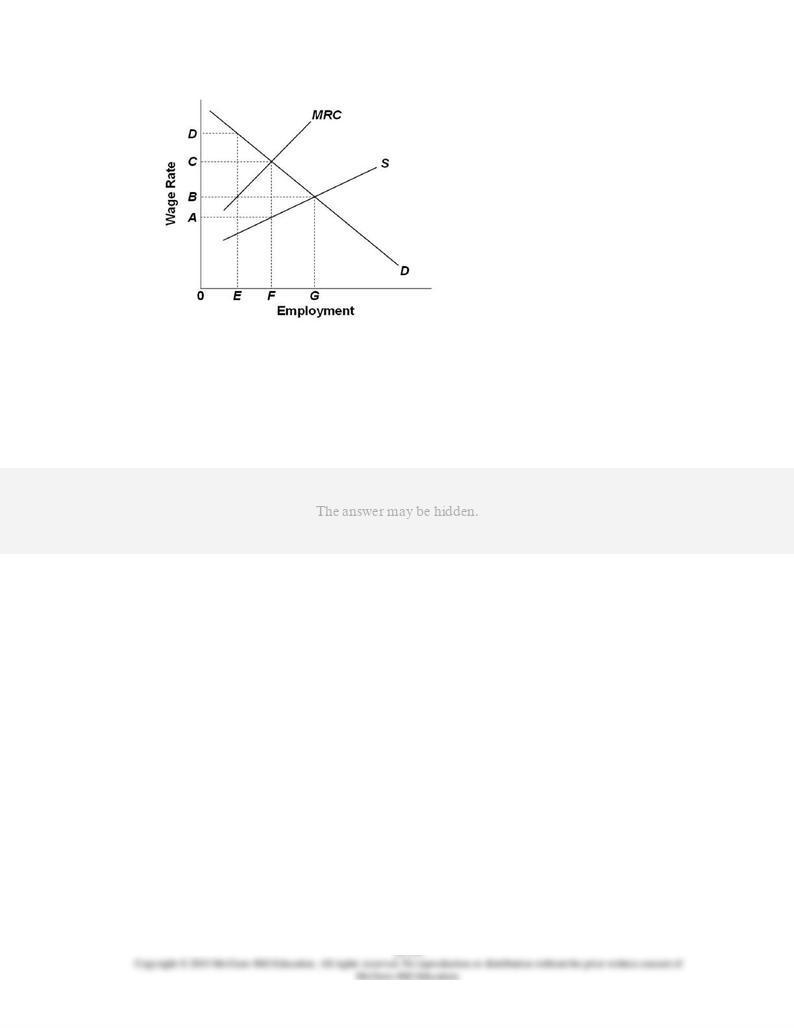
85.
Refer to the diagram. Assume that an inclusive union is formed to bargain with the
monopsonistic employer of the question. To what level can this union increase the wage
rate without causing the number of jobs to decline below that which the monopsonist
would otherwise have provided?
AACSB: Reflective Thinking
Blooms: Analyze
Difficulty: 3 Hard
Learning Objective: 15-04 Discuss how unions increase wage rates by pursuing the demand-enhancement model; the
craft union model; or the industrial union model.
Topic: Three union models
Type: Graph
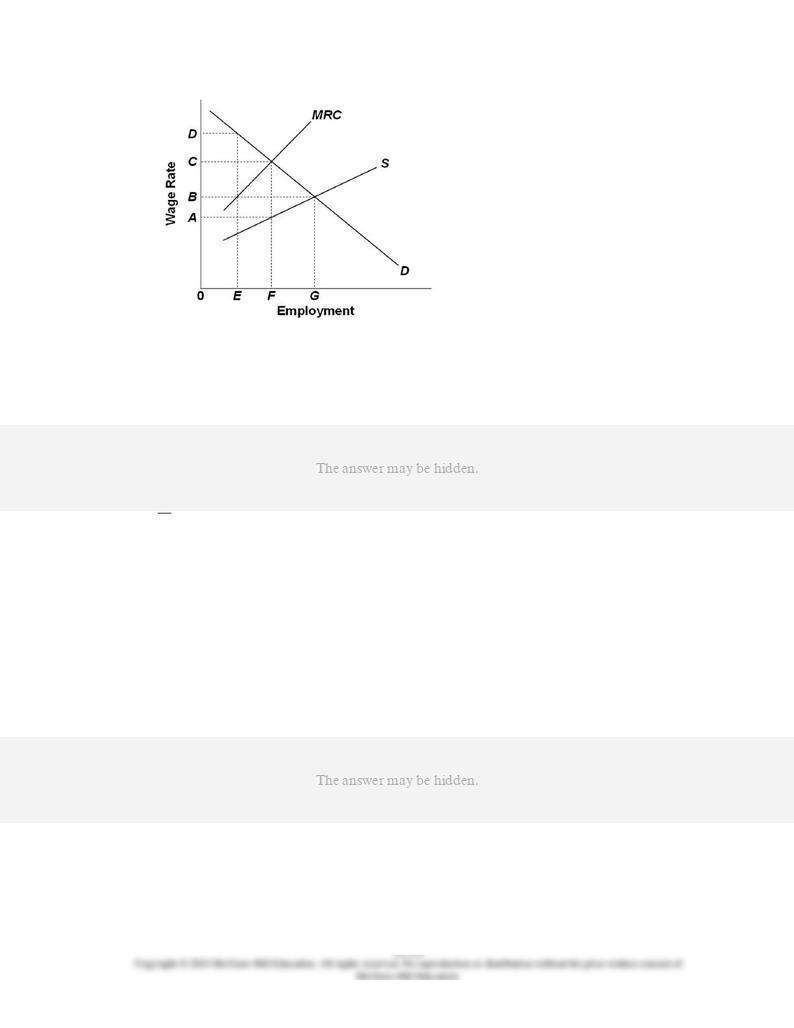
86.
Refer to the diagram. If an inclusive union seeks to maximize the number of jobs available
for its members, what wage rate will it seek to impose on the monopsonist?
AACSB: Reflective Thinking
Blooms: Analyze
Difficulty: 3 Hard
Learning Objective: 15-04 Discuss how unions increase wage rates by pursuing the demand-enhancement model; the
craft union model; or the industrial union model.
Topic: Three union models
Type: Graph
87.
A craft union attempts to increase wage rates by:
AACSB: Reflective Thinking
Accessibility: Keyboard Navigation
Blooms: Understand
Difficulty: 2 Medium

Learning Objective: 15-04 Discuss how unions increase wage rates by pursuing the demand-enhancement model; the
craft union model; or the industrial union model.
Topic: Three union models
88.
Occupational licensing has much the same effect as:
AACSB: Analytic
Accessibility: Keyboard Navigation
Blooms: Remember
Difficulty: 1 Easy
Learning Objective: 15-04 Discuss how unions increase wage rates by pursuing the demand-enhancement model; the
craft union model; or the industrial union model.
Topic: Three union models
89.
Occupational licensing:
AACSB: Analytic
Accessibility: Keyboard Navigation
Blooms: Remember
Difficulty: 1 Easy
Learning Objective: 15-04 Discuss how unions increase wage rates by pursuing the demand-enhancement model; the
craft union model; or the industrial union model.
Topic: Three union models

90.
If an exclusive union is successful in restricting the supply of labor, the:
AACSB: Reflective Thinking
Accessibility: Keyboard Navigation
Blooms: Analyze
Difficulty: 3 Hard
Learning Objective: 15-04 Discuss how unions increase wage rates by pursuing the demand-enhancement model; the
craft union model; or the industrial union model.
Topic: Three union models
91.
If an industrial union is formed to bargain with a monopsonistic employer, then in this
labor market:
AACSB: Reflective Thinking
Accessibility: Keyboard Navigation
Blooms: Analyze
Difficulty: 3 Hard
Learning Objective: 15-04 Discuss how unions increase wage rates by pursuing the demand-enhancement model; the
craft union model; or the industrial union model.
Topic: Three union models

92.
The electricians' union is a good example of:
AACSB: Reflective Thinking
Accessibility: Keyboard Navigation
Blooms: Apply
Difficulty: 2 Medium
Learning Objective: 15-04 Discuss how unions increase wage rates by pursuing the demand-enhancement model; the
craft union model; or the industrial union model.
Topic: Three union models
93.
Labor unions may attempt to raise wage rates by:
AACSB: Reflective Thinking
Accessibility: Keyboard Navigation
Blooms: Understand
Difficulty: 2 Medium
Learning Objective: 15-04 Discuss how unions increase wage rates by pursuing the demand-enhancement model; the
craft union model; or the industrial union model.
Topic: Three union models

94.
Construction workers frequently sponsor political lobbying in support of greater public
spending on highways and public buildings. One reason for this is to:
AACSB: Reflective Thinking
Accessibility: Keyboard Navigation
Blooms: Apply
Difficulty: 2 Medium
Learning Objective: 15-04 Discuss how unions increase wage rates by pursuing the demand-enhancement model; the
craft union model; or the industrial union model.
Topic: Three union models
95.
Unions often oppose increases in the prices of complementary inputs (for example, truck
drivers may oppose increases in taxes on diesel fuel). They do this because increases in
the prices of complementary inputs might:
AACSB: Reflective Thinking
Accessibility: Keyboard Navigation
Blooms: Understand
Difficulty: 2 Medium
Learning Objective: 15-04 Discuss how unions increase wage rates by pursuing the demand-enhancement model; the
craft union model; or the industrial union model.
Topic: Three union models

96.
Craft unions:
AACSB: Analytic
Accessibility: Keyboard Navigation
Blooms: Remember
Difficulty: 1 Easy
Learning Objective: 15-04 Discuss how unions increase wage rates by pursuing the demand-enhancement model; the
craft union model; or the industrial union model.
Topic: Three union models
97.
Labor unions are restrained in their wage demands because:
AACSB: Reflective Thinking
Accessibility: Keyboard Navigation
Blooms: Understand
Difficulty: 2 Medium
Learning Objective: 15-04 Discuss how unions increase wage rates by pursuing the demand-enhancement model; the
craft union model; or the industrial union model.
Topic: Three union models
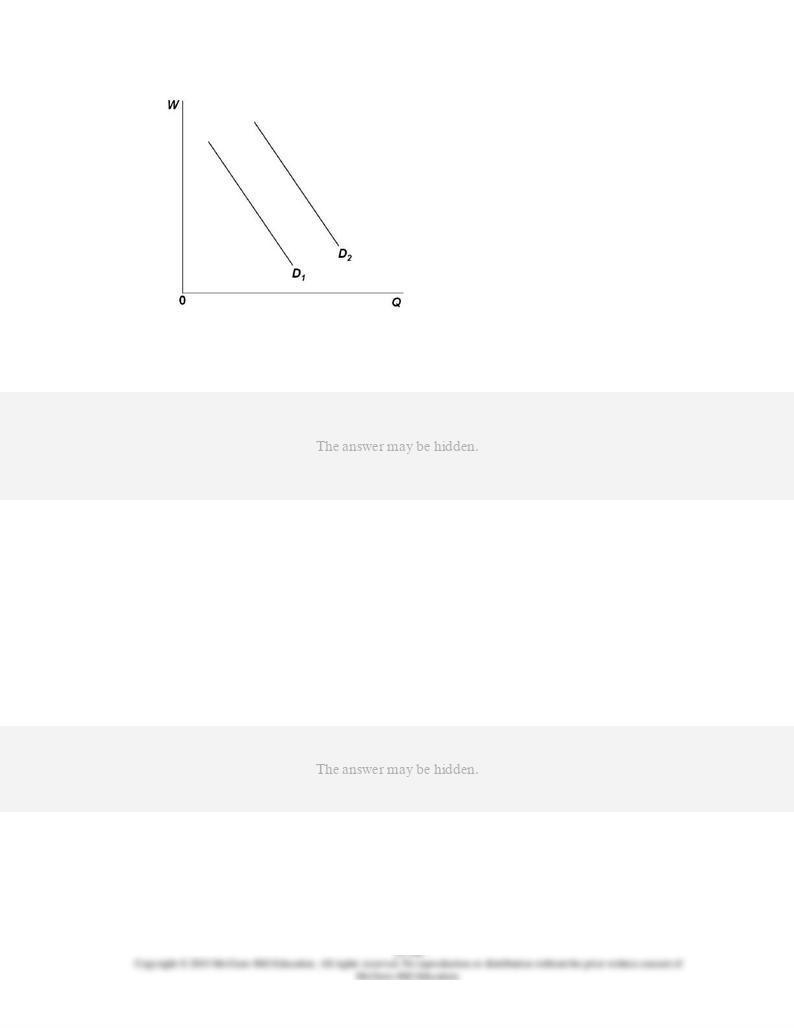
98.
A shift in union labor demand from
D
1 to
D
2 in the diagram might be the result of:
AACSB: Reflective Thinking
Blooms: Apply
Difficulty: 2 Medium
Learning Objective: 15-04 Discuss how unions increase wage rates by pursuing the demand-enhancement model; the
craft union model; or the industrial union model.
Topic: Three union models
Type: Graph
99.
A union might increase the demand for the labor services of its members by:
AACSB: Reflective Thinking
Accessibility: Keyboard Navigation
Blooms: Analyze
Difficulty: 3 Hard
Learning Objective: 15-04 Discuss how unions increase wage rates by pursuing the demand-enhancement model; the

craft union model; or the industrial union model.
Topic: Three union models
100.
Authoritative estimates suggest that currently union workers on the average:
AACSB: Reflective Thinking
Accessibility: Keyboard Navigation
Blooms: Remember
Difficulty: 1 Easy
Learning Objective: 15-04 Discuss how unions increase wage rates by pursuing the demand-enhancement model; the
craft union model; or the industrial union model.
Topic: Three union models
101.
In a labor market characterized by bilateral monopoly, the wage rate will:
AACSB: Reflective Thinking
Accessibility: Keyboard Navigation
Blooms: Understand
Difficulty: 2 Medium
Learning Objective: 15-05 Explain why wages and employment are determined by collective bargaining in a situation of
bilateral monopoly.
Topic: Bilateral monopoly model

102.
If a single large employer bargains with an inclusive union, the resulting labor market
model can best be described as:
AACSB: Analytic
Accessibility: Keyboard Navigation
Blooms: Remember
Difficulty: 1 Easy
Learning Objective: 15-05 Explain why wages and employment are determined by collective bargaining in a situation of
bilateral monopoly.
Topic: Bilateral monopoly model
103.
Bilateral monopoly occurs where:
AACSB: Analytic
Accessibility: Keyboard Navigation
Blooms: Remember
Difficulty: 1 Easy
Learning Objective: 15-05 Explain why wages and employment are determined by collective bargaining in a situation of
bilateral monopoly.
Topic: Bilateral monopoly model

104.
A.
5.
B.
4.
D.
2.
AACSB: Reflective Thinking
Blooms: Apply
Difficulty: 2 Medium
Learning Objective: 15-04 Discuss how unions increase wage rates by pursuing the demand-enhancement model; the
craft union model; or the industrial union model.
Topic: Three union models
Type: Graph

105.
A.
4.
B.
3.
C.
2.
AACSB: Reflective Thinking
Blooms: Apply
Difficulty: 2 Medium
Learning Objective: 15-04 Discuss how unions increase wage rates by pursuing the demand-enhancement model; the
craft union model; or the industrial union model.
Topic: Three union models
Type: Graph

106.
Refer to the labor market diagrams. The tactics of inclusive unionism are shown in
Figure(s):
AACSB: Reflective Thinking
Blooms: Apply
Difficulty: 2 Medium
Learning Objective: 15-04 Discuss how unions increase wage rates by pursuing the demand-enhancement model; the
craft union model; or the industrial union model.
Topic: Three union models
Type: Graph

107.
B.
4.
C.
2.
D.
1.
AACSB: Reflective Thinking
Blooms: Apply
Difficulty: 2 Medium
Learning Objective: 15-05 Explain why wages and employment are determined by collective bargaining in a situation of
bilateral monopoly.
Topic: Bilateral monopoly model
Type: Graph
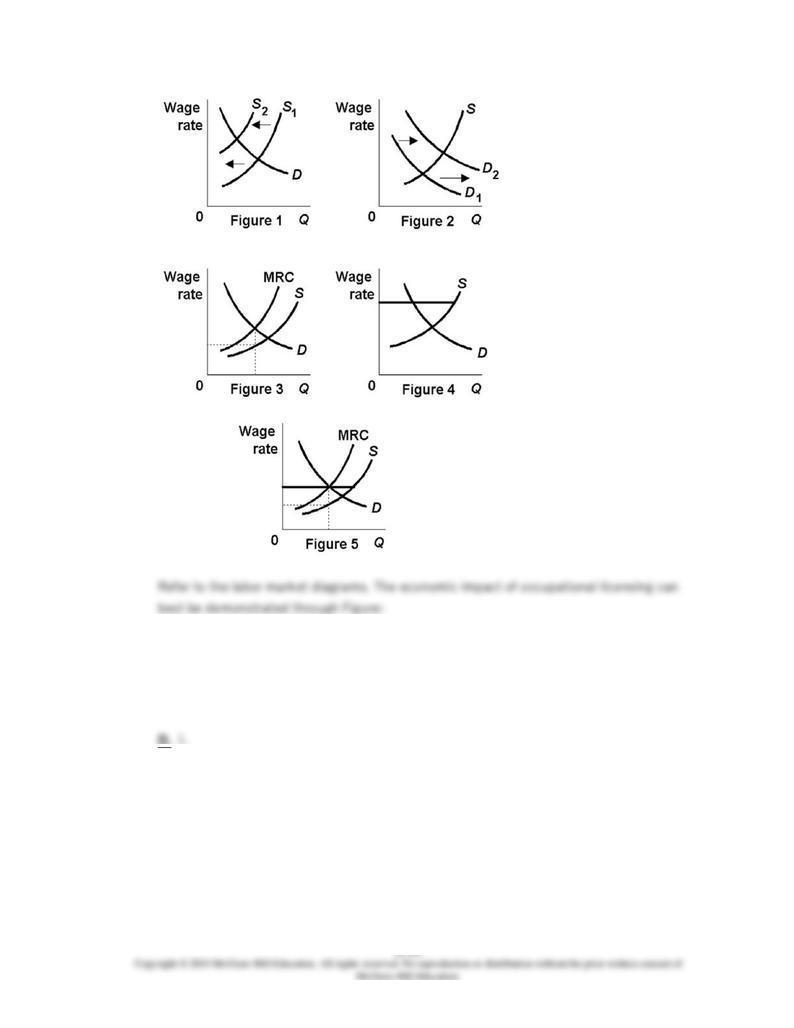
108.
A.
4.
B.
3.
C.
2.
AACSB: Reflective Thinking
Blooms: Apply
Difficulty: 2 Medium
Learning Objective: 15-04 Discuss how unions increase wage rates by pursuing the demand-enhancement model; the
craft union model; or the industrial union model.
Topic: Three union models
Type: Graph
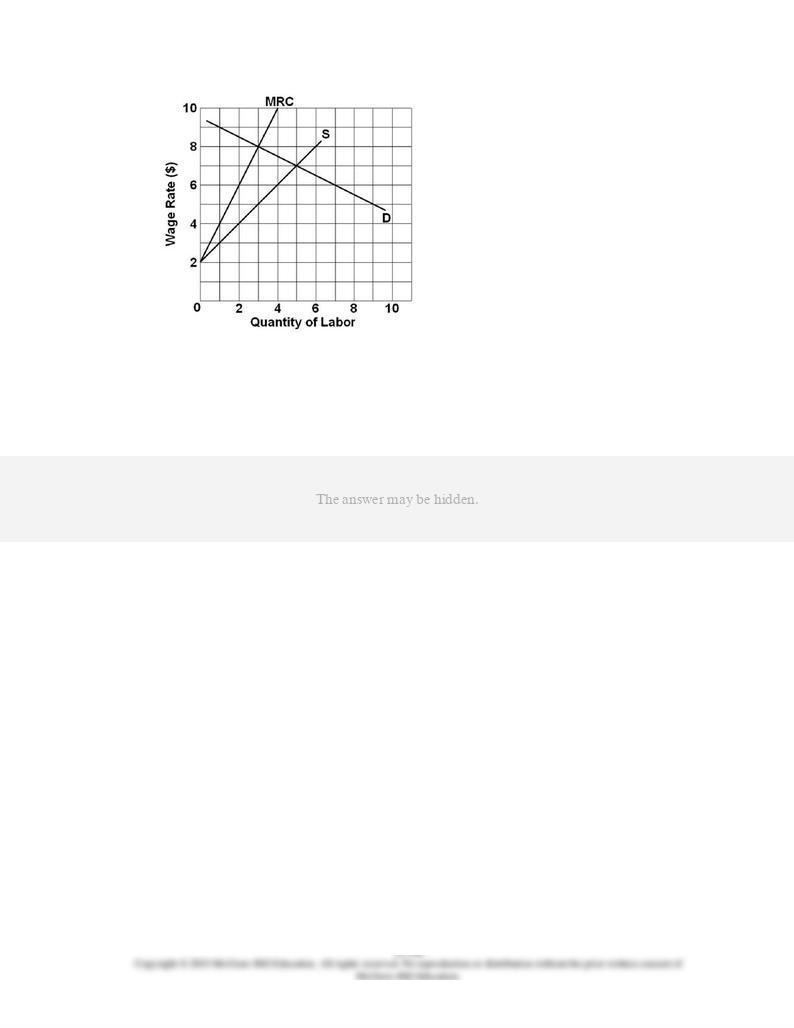
109.
Refer to the labor market diagram where
D
is the labor demand curve,
S
is the labor
supply curve, and MRC is the marginal resource (labor) cost curve. If this were a purely
competitive labor market, the equilibrium wage rate and level of employment would be:
AACSB: Reflective Thinking
Blooms: Analyze
Difficulty: 3 Hard
Learning Objective: 15-04 Discuss how unions increase wage rates by pursuing the demand-enhancement model; the
craft union model; or the industrial union model.
Topic: Three union models
Type: Graph

110.
Refer to the labor market diagram where
D
is the labor demand curve,
S
is the labor
supply curve, and MRC is the marginal resource (labor) cost curve. If this were a
monopsonistic labor market, the equilibrium wage rate and level of employment would be:
AACSB: Reflective Thinking
Blooms: Analyze
Difficulty: 3 Hard
Learning Objective: 15-04 Discuss how unions increase wage rates by pursuing the demand-enhancement model; the
craft union model; or the industrial union model.
Topic: Three union models
Type: Graph
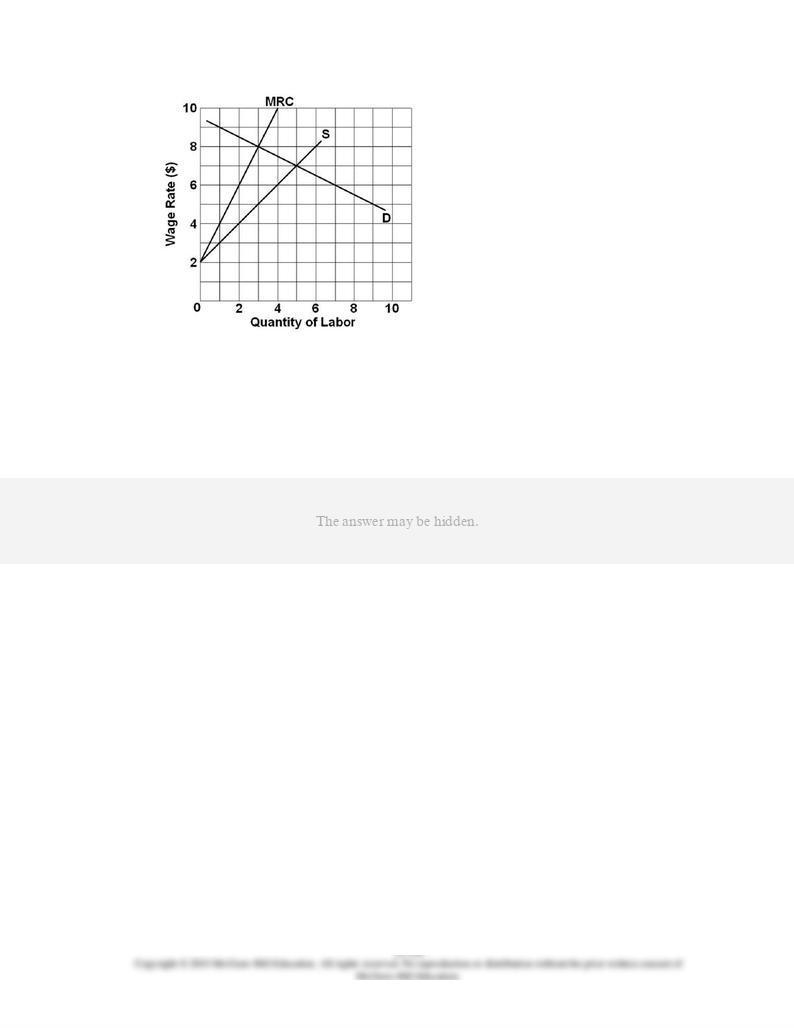
111.
Refer to the labor market diagram where
D
is the labor demand curve,
S
is the labor
supply curve, and MRC is the marginal resource (labor) cost curve. If an inclusive union
was formed and was able to get the monopsonist to agree to a $7 wage rate, then the
monopsonist would:
AACSB: Reflective Thinking
Blooms: Analyze
Difficulty: 3 Hard
Learning Objective: 15-04 Discuss how unions increase wage rates by pursuing the demand-enhancement model; the
craft union model; or the industrial union model.
Topic: Three union models
Type: Graph
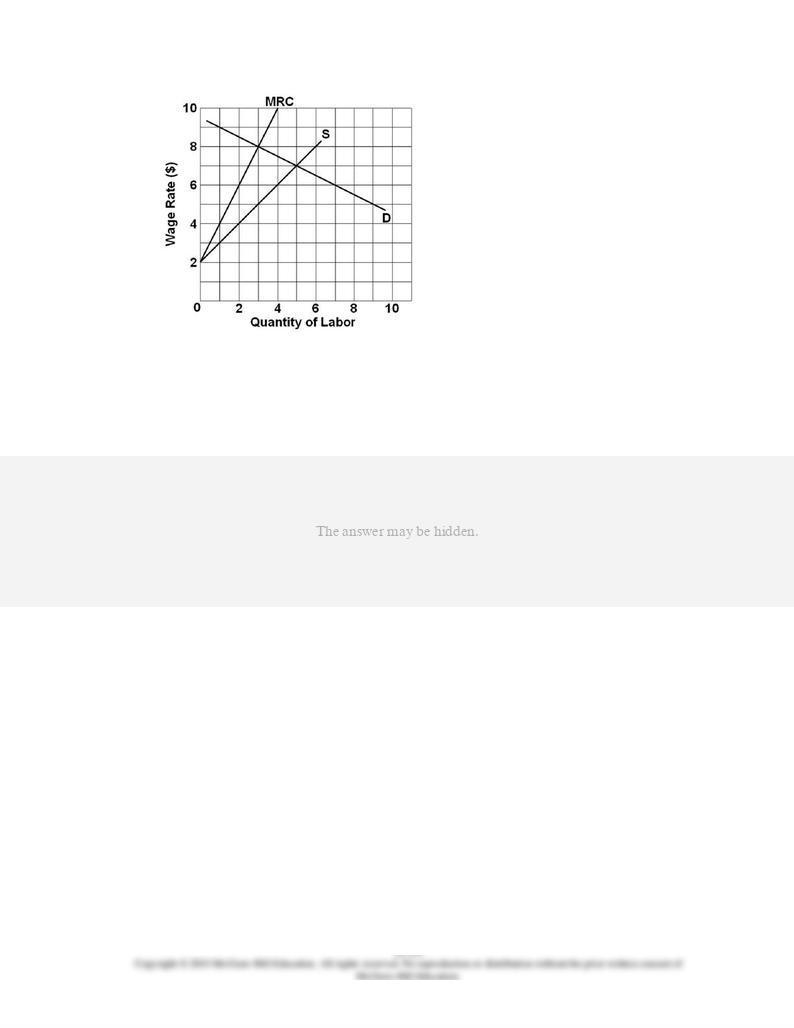
112.
Refer to the labor market diagram where
D
is the labor demand curve,
S
is the labor
supply curve, and MRC is the marginal resource (labor) cost curve. If an inclusive union
was able to get the monopsonist to pay a $6 wage rate, then:
AACSB: Reflective Thinking
Blooms: Apply
Difficulty: 2 Medium
Learning Objective: 15-04 Discuss how unions increase wage rates by pursuing the demand-enhancement model; the
craft union model; or the industrial union model.
Topic: Three union models
Type: Graph
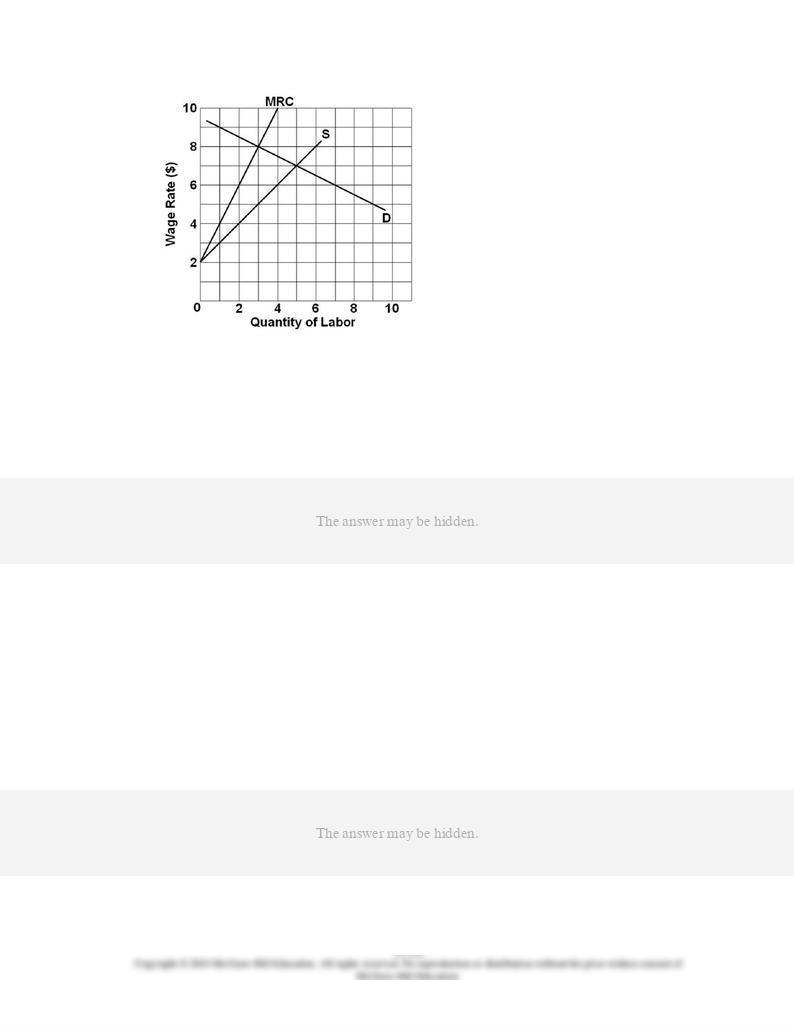
113.
Refer to the labor market diagram where
D
is the labor demand curve,
S
is the labor
supply curve, and MRC is the marginal resource (labor) cost curve. An inclusive union
could increase the level of employment above that which the monopsonist would provide if
it could get the monopsonist to agree to any wage rate:
AACSB: Reflective Thinking
Blooms: Analyze
Difficulty: 3 Hard
Learning Objective: 15-04 Discuss how unions increase wage rates by pursuing the demand-enhancement model; the
craft union model; or the industrial union model.
Topic: Three union models
Type: Graph
114.
Minimum-wage legislation is
less
likely to have adverse effects on employment when the:
AACSB: Reflective Thinking

Accessibility: Keyboard Navigation
Blooms: Understand
Difficulty: 2 Medium
Learning Objective: 15-06 Discuss how minimum wage laws affect labor markets.
Topic: Minimum-wage controversy
115.
Critics of minimum-wage legislation argue that it:
AACSB: Reflective Thinking
Accessibility: Keyboard Navigation
Blooms: Remember
Difficulty: 1 Easy
Learning Objective: 15-06 Discuss how minimum wage laws affect labor markets.
Topic: Minimum-wage controversy
116.
Many economists are critical of the minimum wage because they believe that it:
AACSB: Reflective Thinking
Accessibility: Keyboard Navigation
Blooms: Remember
Difficulty: 1 Easy
Learning Objective: 15-06 Discuss how minimum wage laws affect labor markets.
Topic: Minimum-wage controversy

117.
Unions might support a higher minimum wage because:
AACSB: Reflective Thinking
Accessibility: Keyboard Navigation
Blooms: Understand
Difficulty: 2 Medium
Learning Objective: 15-06 Discuss how minimum wage laws affect labor markets.
Topic: Minimum-wage controversy
118.
Critics of the minimum wage argue that as an antipoverty device it is "poorly targeted." By
this they mean that:
AACSB: Reflective Thinking
Accessibility: Keyboard Navigation
Blooms: Remember
Difficulty: 1 Easy
Learning Objective: 15-06 Discuss how minimum wage laws affect labor markets.
Topic: Minimum-wage controversy

119.
If the minimum wage is set too high, in some labor markets we can expect to see:
AACSB: Reflective Thinking
Accessibility: Keyboard Navigation
Blooms: Analyze
Difficulty: 3 Hard
Learning Objective: 15-06 Discuss how minimum wage laws affect labor markets.
Topic: Minimum-wage controversy
120.
According to some supporters of the minimum wage, it has very small or even nonexistent
negative employment effects because:
AACSB: Reflective Thinking
Accessibility: Keyboard Navigation
Blooms: Remember
Difficulty: 1 Easy
Learning Objective: 15-06 Discuss how minimum wage laws affect labor markets.
Topic: Minimum-wage controversy

121.
If all workers are homogeneous, all jobs are equally attractive to workers, and labor
markets are perfectly competitive:
AACSB: Reflective Thinking
Accessibility: Keyboard Navigation
Blooms: Analyze
Difficulty: 3 Hard
Learning Objective: 15-07 List the major causes of wage differentials.
Topic: Wage differentials
122.
Wage differentials may result from all the following
except
:
AACSB: Analytic
Accessibility: Keyboard Navigation
Blooms: Understand
Difficulty: 2 Medium
Learning Objective: 15-07 List the major causes of wage differentials.
Topic: Wage differentials

123.
Suppose all workers are identical but working for Ajax is more pleasant than working for
Acme. In all other nonwage aspects, the two firms offer the same job characteristics. We
would expect:
AACSB: Reflective Thinking
Accessibility: Keyboard Navigation
Blooms: Apply
Difficulty: 2 Medium
Learning Objective: 15-07 List the major causes of wage differentials.
Topic: Wage differentials
124.
Noncompeting groups of workers are the result of:
AACSB: Analytic
Accessibility: Keyboard Navigation
Blooms: Remember
Difficulty: 1 Easy
Learning Objective: 15-07 List the major causes of wage differentials.
Topic: Wage differentials
125.
Compensating differences in wages:
AACSB: Analytic

Accessibility: Keyboard Navigation
Blooms: Remember
Difficulty: 1 Easy
Learning Objective: 15-07 List the major causes of wage differentials.
Topic: Wage differentials
126.
Compensating differences in wages, pay workers for:
AACSB: Analytic
Accessibility: Keyboard Navigation
Blooms: Remember
Difficulty: 1 Easy
Learning Objective: 15-07 List the major causes of wage differentials.
Topic: Wage differentials
127.
Which of the following factors is
not
relevant in explaining the persistence of wage
differentials?
AACSB: Analytic
Accessibility: Keyboard Navigation
Blooms: Understand
Difficulty: 2 Medium
Learning Objective: 15-07 List the major causes of wage differentials.
Topic: Wage differentials

128.
The idea of compensating differences is used:
AACSB: Analytic
Accessibility: Keyboard Navigation
Blooms: Understand
Difficulty: 2 Medium
Learning Objective: 15-07 List the major causes of wage differentials.
Topic: Wage differentials
129.
The concept of investment in human capital indicates that:
AACSB: Reflective Thinking
Accessibility: Keyboard Navigation
Blooms: Understand
Difficulty: 2 Medium
Learning Objective: 15-07 List the major causes of wage differentials.
Topic: Wage differentials
130.
Data on education and earnings reveal:
AACSB: Reflective Thinking
Accessibility: Keyboard Navigation
Blooms: Remember

Difficulty: 1 Easy
Learning Objective: 15-07 List the major causes of wage differentials.
Topic: Wage differentials
131.
According to age-earnings data,
AACSB: Reflective Thinking
Accessibility: Keyboard Navigation
Blooms: Remember
Difficulty: 1 Easy
Learning Objective: 15-07 List the major causes of wage differentials.
Topic: Wage differentials
132.
The earnings of highly educated workers:
AACSB: Reflective Thinking
Accessibility: Keyboard Navigation
Blooms: Remember
Difficulty: 1 Easy
Learning Objective: 15-07 List the major causes of wage differentials.
Topic: Wage differentials

133.
Economists regard expenditures on education as investments because:
AACSB: Reflective Thinking
Accessibility: Keyboard Navigation
Blooms: Understand
Difficulty: 2 Medium
Learning Objective: 15-07 List the major causes of wage differentials.
Topic: Wage differentials
134.
Which of the following involves the creation of human capital?
AACSB: Reflective Thinking
Accessibility: Keyboard Navigation
Blooms: Apply
Difficulty: 2 Medium
Learning Objective: 15-07 List the major causes of wage differentials.
Topic: Wage differentials
135.
Human capital is best defined as:
AACSB: Analytic
Accessibility: Keyboard Navigation
Blooms: Remember

Difficulty: 1 Easy
Learning Objective: 15-07 List the major causes of wage differentials.
Topic: Wage differentials
136.
Which of the following is a
market
imperfection
that might explain persistent wage
differentials within an occupation?
AACSB: Analytic
Accessibility: Keyboard Navigation
Blooms: Remember
Difficulty: 1 Easy
Learning Objective: 15-07 List the major causes of wage differentials.
Topic: Wage differentials
137.
Which of the following is a
market
imperfection
that might explain persistent wage
differentials within an occupation?
AACSB: Analytic
Accessibility: Keyboard Navigation
Blooms: Remember
Difficulty: 1 Easy
Learning Objective: 15-07 List the major causes of wage differentials.
Topic: Wage differentials

138.
Which of the following is
not
an example of a market imperfection that might explain
persistent wage differentials within an occupation?
AACSB: Analytic
Accessibility: Keyboard Navigation
Blooms: Remember
Difficulty: 1 Easy
Learning Objective: 15-07 List the major causes of wage differentials.
Topic: Wage differentials
139.
Jack and Jill have identical skills and training, but Jill earns higher wages in her job. Which
of the following reasons would best explain why Jill earns more than Jack?
AACSB: Reflective Thinking
Accessibility: Keyboard Navigation
Blooms: Apply
Difficulty: 2 Medium
Learning Objective: 15-07 List the major causes of wage differentials.
Topic: Wage differentials

140.
The principal-agent problem arises in labor markets because:
AACSB: Reflective Thinking
Accessibility: Keyboard Navigation
Blooms: Understand
Difficulty: 2 Medium
Learning Objective: 15-08 Identify the types; benefits; and costs of "pay-for-performance" plans.
Topic: Pay for performance
141.
The principal-agent problem arises primarily because:
AACSB: Analytic
Accessibility: Keyboard Navigation
Blooms: Remember
Difficulty: 1 Easy
Learning Objective: 15-08 Identify the types; benefits; and costs of "pay-for-performance" plans.
Topic: Pay for performance

142.
Which one of the following best exemplifies the principal-agent problem in the employer-
employee relationship?
AACSB: Reflective Thinking
Accessibility: Keyboard Navigation
Blooms: Apply
Difficulty: 2 Medium
Learning Objective: 15-08 Identify the types; benefits; and costs of "pay-for-performance" plans.
Topic: Pay for performance
143.
In the context of labor markets, shirking refers to:
AACSB: Analytic
Accessibility: Keyboard Navigation
Blooms: Remember
Difficulty: 1 Easy
Learning Objective: 15-08 Identify the types; benefits; and costs of "pay-for-performance" plans.
Topic: Pay for performance

144.
Traveling sales representative Harold Hill only calls on clients four days a week rather
than the five days expected by his employer. This is an example of:
AACSB: Reflective Thinking
Accessibility: Keyboard Navigation
Blooms: Apply
Difficulty: 2 Medium
Learning Objective: 15-08 Identify the types; benefits; and costs of "pay-for-performance" plans.
Topic: Pay for performance
145.
The idea of efficiency wages is that:
AACSB: Analytic
Accessibility: Keyboard Navigation
Blooms: Remember
Difficulty: 1 Easy
Learning Objective: 15-08 Identify the types; benefits; and costs of "pay-for-performance" plans.
Topic: Pay for performance
146.
Paying an above-equilibrium wage rate might reduce unit labor costs by:
AACSB: Reflective Thinking
Accessibility: Keyboard Navigation
Blooms: Understand

Difficulty: 2 Medium
Learning Objective: 15-08 Identify the types; benefits; and costs of "pay-for-performance" plans.
Topic: Pay for performance
147.
Compensation paid in proportion to the number of units of personal output best
describes:
AACSB: Analytic
Accessibility: Keyboard Navigation
Blooms: Remember
Difficulty: 1 Easy
Learning Objective: 15-08 Identify the types; benefits; and costs of "pay-for-performance" plans.
Topic: Pay for performance
148.
A firm might choose to pay its employees a wage higher than that which would clear the
market because:
AACSB: Reflective Thinking
Accessibility: Keyboard Navigation
Blooms: Understand
Difficulty: 2 Medium
Learning Objective: 15-08 Identify the types; benefits; and costs of "pay-for-performance" plans.
Topic: Pay for performance

149.
For the firm, the
major
goal of profit sharing plans is to:
AACSB: Reflective Thinking
Accessibility: Keyboard Navigation
Blooms: Understand
Difficulty: 2 Medium
Learning Objective: 15-08 Identify the types; benefits; and costs of "pay-for-performance" plans.
Topic: Pay for performance
150.
Stock options as a form of payment are designed to:
AACSB: Reflective Thinking
Accessibility: Keyboard Navigation
Blooms: Apply
Difficulty: 2 Medium
Learning Objective: 15-08 Identify the types; benefits; and costs of "pay-for-performance" plans.
Topic: Pay for performance

151.
One of the potential negative side-effects of pay in the form of sales commissions is:
AACSB: Reflective Thinking
Accessibility: Keyboard Navigation
Blooms: Understand
Difficulty: 2 Medium
Learning Objective: 15-08 Identify the types; benefits; and costs of "pay-for-performance" plans.
Topic: Pay for performance
152.
(Consider This) The main idea highlighted in the story about artist Pablo Picasso is:
AACSB: Reflective Thinking
Accessibility: Keyboard Navigation
Blooms: Apply
Difficulty: 2 Medium
Learning Objective: 15-07 List the major causes of wage differentials.
Topic: Wage differentials
153.
(Consider This) The story about artist Pablo Picasso illustrates the point that:
AACSB: Reflective Thinking

Accessibility: Keyboard Navigation
Blooms: Apply
Difficulty: 2 Medium
Learning Objective: 15-07 List the major causes of wage differentials.
Topic: Wage differentials
154.
(Consider This) Which of the following statements is true about the relationship between
take-home pay and fringe benefits for U.S. middle-class workers over the past several
decades?
AACSB: Reflective Thinking
Accessibility: Keyboard Navigation
Blooms: Remember
Difficulty: 1 Easy
Learning Objective: 15-07 List the major causes of wage differentials.
Topic: Wage differentials
155.
(Consider This) Which of the following best explains why total compensation for U.S.
workers has increased significantly over the past several decades, but take-home pay by
U.S. workers has increased by much less?
AACSB: Reflective Thinking
Accessibility: Keyboard Navigation
Blooms: Remember
Difficulty: 1 Easy
Learning Objective: 15-07 List the major causes of wage differentials.

Topic: Wage differentials
156.
(Last Word) Chief executive officers (CEOs) of large American corporations:
AACSB: Reflective Thinking
Accessibility: Keyboard Navigation
Blooms: Apply
Difficulty: 2 Medium
Learning Objective: 15-07 List the major causes of wage differentials.
Topic: Wage differentials
157.
(Last Word) In 2005, chief executive officers' (CEOs') pay at U.S. firms with around $500
million in annual sales averaged:
AACSB: Reflective Thinking
Accessibility: Keyboard Navigation
Blooms: Apply
Difficulty: 2 Medium
Learning Objective: 15-07 List the major causes of wage differentials.
Topic: Wage differentials

158.
(Last Word) The dispute over the pay of chief executive officers (CEOs) of U.S.
corporations hinges on whether or not such pay:
AACSB: Reflective Thinking
Accessibility: Keyboard Navigation
Blooms: Apply
Difficulty: 2 Medium
Learning Objective: 15-07 List the major causes of wage differentials.
Topic: Wage differentials
True / False Questions
159.
Marginal resource (labor) cost will exceed the wage rate when there is imperfect
competition in the hire of labor.
AACSB: Reflective Thinking
Accessibility: Keyboard Navigation
Blooms: Remember
Difficulty: 1 Easy
Learning Objective: 15-03 Demonstrate how monopsony (a market with a single employer) can reduce wages below
competitive levels.
Topic: Monopsony model

160.
The rising general level of real wages in the United States has occurred because growing
population has increased the supply of labor relative to the demand for it.
AACSB: Reflective Thinking
Accessibility: Keyboard Navigation
Blooms: Remember
Difficulty: 1 Easy
Learning Objective: 15-01 Explain why labor productivity and real hourly compensation track so closely over time.
Topic: Labor, wages, and earnings
161.
Marginal resource (labor) cost will always exceed the wage rate when the employer is
selling its product in an imperfectly competitive market.
AACSB: Analytic
Accessibility: Keyboard Navigation
Blooms: Understand
Difficulty: 2 Medium
Learning Objective: 15-02 Show how wage rates and employment levels are determined in competitive labor markets.
Learning Objective: 15-03 Demonstrate how monopsony (a market with a single employer) can reduce wages below
competitive levels.
Topic: Monopsony model
Topic: Purely competitive labor markets
162.
A monopsonistic employer may sell its product in a competitive market.
AACSB: Analytic
Accessibility: Keyboard Navigation
Blooms: Remember
Difficulty: 1 Easy
Learning Objective: 15-03 Demonstrate how monopsony (a market with a single employer) can reduce wages below
competitive levels.
Topic: Monopsony model

163.
Industrial unions are more likely to increase wage rates by restricting the supply of labor
than are craft unions.
AACSB: Reflective Thinking
Accessibility: Keyboard Navigation
Blooms: Understand
Difficulty: 2 Medium
Learning Objective: 15-04 Discuss how unions increase wage rates by pursuing the demand-enhancement model; the
craft union model; or the industrial union model.
Topic: Three union models
164.
The labor supply curve facing a purely competitive firm is perfectly inelastic.
AACSB: Reflective Thinking
Accessibility: Keyboard Navigation
Blooms: Remember
Difficulty: 1 Easy
Learning Objective: 15-02 Show how wage rates and employment levels are determined in competitive labor markets.
Topic: Purely competitive labor markets
165.
The monopsonist in a nonunionized labor market pays a wage rate below the MRP of
labor.
AACSB: Reflective Thinking
Accessibility: Keyboard Navigation
Blooms: Understand
Difficulty: 2 Medium
Learning Objective: 15-03 Demonstrate how monopsony (a market with a single employer) can reduce wages below
competitive levels.
Topic: Monopsony model

166.
Inclusive unions restrict the number of jobs directly by shifting the labor supply curve to
the left; exclusive unions restrict the number of jobs by imposing above-equilibrium wage
rates on the employer.
AACSB: Reflective Thinking
Accessibility: Keyboard Navigation
Blooms: Understand
Difficulty: 2 Medium
Learning Objective: 15-04 Discuss how unions increase wage rates by pursuing the demand-enhancement model; the
craft union model; or the industrial union model.
Topic: Three union models
167.
Critics of the minimum wage contend that higher minimums cause employers to move up
their labor demand curves, reducing employment of low-wage workers.
AACSB: Reflective Thinking
Accessibility: Keyboard Navigation
Blooms: Remember
Difficulty: 1 Easy
Learning Objective: 15-06 Discuss how minimum wage laws affect labor markets.
Topic: Minimum-wage controversy
168.
The principal-agent problem in labor markets arises because of the possibility of shirking
by workers.
AACSB: Reflective Thinking
Accessibility: Keyboard Navigation
Blooms: Remember
Difficulty: 1 Easy
Learning Objective: 15-08 Identify the types; benefits; and costs of "pay-for-performance" plans.
Topic: Pay for performance
169.
Efficiency wages are established at below-equilibrium levels.
AACSB: Analytic

Accessibility: Keyboard Navigation
Blooms: Understand
Difficulty: 2 Medium
Learning Objective: 15-08 Identify the types; benefits; and costs of "pay-for-performance" plans.
Topic: Pay for performance
170.
Human capital investment refers to spending on education and worker training.
AACSB: Analytic
Accessibility: Keyboard Navigation
Blooms: Remember
Difficulty: 1 Easy
Learning Objective: 15-07 List the major causes of wage differentials.
Topic: Wage differentials
171.
Noncompeting groups of workers are the result of geographic immobilities.
AACSB: Analytic
Accessibility: Keyboard Navigation
Blooms: Remember
Difficulty: 1 Easy
Learning Objective: 15-07 List the major causes of wage differentials.
Topic: Wage differentials
172.
Shirking refers to the behavior of workers who provide less-than-expected effort on the
job.
AACSB: Analytic
Accessibility: Keyboard Navigation
Blooms: Remember
Difficulty: 1 Easy
Learning Objective: 15-08 Identify the types; benefits; and costs of "pay-for-performance" plans.
Topic: Pay for performance

173.
Piece-rates may not be appropriate pay in some situations because they might reduce
product quality.
AACSB: Reflective Thinking
Accessibility: Keyboard Navigation
Blooms: Understand
Difficulty: 2 Medium
Learning Objective: 15-08 Identify the types; benefits; and costs of "pay-for-performance" plans.
Topic: Pay for performance
Multiple Choice Questions
174.
In 2011, there were about _____ million union members in the United States.
A.
8.4
B.
11.8
D.
15.7
AACSB: Reflective Thinking
Accessibility: Keyboard Navigation
Blooms: Remember
Difficulty: 1 Easy
Learning Objective: 15-09 (Appendix) Relate who belongs to U.S. unions; the basics of collective bargaining; and the
economic effects of unions.
Topic: Decline of unionism
Topic: Union membership

175.
In 2011, about ____ percent of employed wage and salary workers belonged to unions.
A.
8.4
B.
5.5
C.
14.8
D.
11.8
AACSB: Reflective Thinking
Accessibility: Keyboard Navigation
Blooms: Remember
Difficulty: 1 Easy
Learning Objective: 15-09 (Appendix) Relate who belongs to U.S. unions; the basics of collective bargaining; and the
economic effects of unions.
Topic: Decline of unionism
Topic: Union membership
176.
In 2011, the U.S. unionization rate was:
A.
5.5 percent, down by nearly one-half of the rate in the mid-1950s.
B.
14.8 percent, up by about one-fourth of the rate in the mid-1950s.
C.
11.8 percent, down by more than one-half of the rate in the mid-1950s.
D.
21.2 percent, down by 4 percentage points from the mid-1950s.
AACSB: Reflective Thinking
Accessibility: Keyboard Navigation
Blooms: Remember
Difficulty: 1 Easy
Learning Objective: 15-09 (Appendix) Relate who belongs to U.S. unions; the basics of collective bargaining; and the
economic effects of unions.
Topic: Decline of unionism
Topic: Union membership

177.
The majority of union members in the United States belong to unions that are:
AACSB: Reflective Thinking
Accessibility: Keyboard Navigation
Blooms: Remember
Difficulty: 1 Easy
Learning Objective: 15-09 (Appendix) Relate who belongs to U.S. unions; the basics of collective bargaining; and the
economic effects of unions.
Topic: Decline of unionism
Topic: Union membership
178.
Independent unions:
AACSB: Reflective Thinking
Accessibility: Keyboard Navigation
Blooms: Remember
Difficulty: 1 Easy
Learning Objective: 15-09 (Appendix) Relate who belongs to U.S. unions; the basics of collective bargaining; and the
economic effects of unions.
Topic: Decline of unionism
Topic: Union membership

179.
AFL-CIO stands for:
AACSB: Analytic
Accessibility: Keyboard Navigation
Blooms: Remember
Difficulty: 1 Easy
Learning Objective: 15-09 (Appendix) Relate who belongs to U.S. unions; the basics of collective bargaining; and the
economic effects of unions.
Topic: Decline of unionism
Topic: Union membership
180.
Suppose in some economy there are 100 million workers; 10 million of those workers work
in retail trade, and 1 million of the retail workers belong to unions. Total union
membership in this economy is 40 million. The rate of unionization in retail trade is:
AACSB: Analytic
Accessibility: Keyboard Navigation
Blooms: Apply
Difficulty: 2 Medium
Learning Objective: 15-09 (Appendix) Relate who belongs to U.S. unions; the basics of collective bargaining; and the
economic effects of unions.
Topic: Decline of unionism
Topic: Union membership

181.
Suppose in some economy there are 100 million workers; 8 million of those workers work
in retail trade, and 2 million of the retail workers belong to unions. Total union
membership in this economy is 30 million. The rate of unionization in the economy is:
AACSB: Analytic
Accessibility: Keyboard Navigation
Blooms: Apply
Difficulty: 2 Medium
Learning Objective: 15-09 (Appendix) Relate who belongs to U.S. unions; the basics of collective bargaining; and the
economic effects of unions.
Topic: Decline of unionism
Topic: Union membership
182.
In the United States, the rate of unionization is:
AACSB: Reflective Thinking
Accessibility: Keyboard Navigation
Blooms: Remember
Difficulty: 1 Easy
Learning Objective: 15-09 (Appendix) Relate who belongs to U.S. unions; the basics of collective bargaining; and the
economic effects of unions.
Topic: Decline of unionism
Topic: Union membership

183.
In which of the following U.S. industries is the rate of unionization the lowest?
AACSB: Reflective Thinking
Accessibility: Keyboard Navigation
Blooms: Remember
Difficulty: 1 Easy
Learning Objective: 15-09 (Appendix) Relate who belongs to U.S. unions; the basics of collective bargaining; and the
economic effects of unions.
Topic: Decline of unionism
Topic: Union membership
184.
In which of the following U.S. industries is the rate of unionization the highest?
AACSB: Reflective Thinking
Accessibility: Keyboard Navigation
Blooms: Remember
Difficulty: 1 Easy
Learning Objective: 15-09 (Appendix) Relate who belongs to U.S. unions; the basics of collective bargaining; and the
economic effects of unions.
Topic: Decline of unionism
Topic: Union membership

185.
In the United States, the rate of unionization is:
AACSB: Reflective Thinking
Accessibility: Keyboard Navigation
Blooms: Remember
Difficulty: 1 Easy
Learning Objective: 15-09 (Appendix) Relate who belongs to U.S. unions; the basics of collective bargaining; and the
economic effects of unions.
Topic: Decline of unionism
Topic: Union membership
186.
In which of the following U.S. occupations is the rate of unionization the highest?
AACSB: Reflective Thinking
Accessibility: Keyboard Navigation
Blooms: Remember
Difficulty: 1 Easy
Learning Objective: 15-09 (Appendix) Relate who belongs to U.S. unions; the basics of collective bargaining; and the
economic effects of unions.
Topic: Decline of unionism
Topic: Union membership

187.
In which of the following U.S. occupations is the rate of unionization the lowest?
AACSB: Reflective Thinking
Accessibility: Keyboard Navigation
Blooms: Remember
Difficulty: 1 Easy
Learning Objective: 15-09 (Appendix) Relate who belongs to U.S. unions; the basics of collective bargaining; and the
economic effects of unions.
Topic: Decline of unionism
Topic: Union membership
188.
In the United States:
AACSB: Reflective Thinking
Accessibility: Keyboard Navigation
Blooms: Remember
Difficulty: 1 Easy
Learning Objective: 15-09 (Appendix) Relate who belongs to U.S. unions; the basics of collective bargaining; and the
economic effects of unions.
Topic: Decline of unionism
Topic: Union membership

189.
In the United States:
AACSB: Reflective Thinking
Accessibility: Keyboard Navigation
Blooms: Remember
Difficulty: 1 Easy
Learning Objective: 15-09 (Appendix) Relate who belongs to U.S. unions; the basics of collective bargaining; and the
economic effects of unions.
Topic: Decline of unionism
Topic: Union membership
190.
Who is the most likely to be a union member in the United States?
AACSB: Reflective Thinking
Accessibility: Keyboard Navigation
Blooms: Remember
Difficulty: 1 Easy
Learning Objective: 15-09 (Appendix) Relate who belongs to U.S. unions; the basics of collective bargaining; and the
economic effects of unions.
Topic: Decline of unionism
Topic: Union membership

191.
Since 1980, labor union membership in the United States has been:
AACSB: Reflective Thinking
Accessibility: Keyboard Navigation
Blooms: Remember
Difficulty: 1 Easy
Learning Objective: 15-09 (Appendix) Relate who belongs to U.S. unions; the basics of collective bargaining; and the
economic effects of unions.
Topic: Decline of unionism
Topic: Union membership
192.
U.S. union membership has declined substantially in recent years. Which of the following
is
not
usually cited as a causal factor?
AACSB: Reflective Thinking
Accessibility: Keyboard Navigation
Blooms: Remember
Difficulty: 1 Easy
Learning Objective: 15-09 (Appendix) Relate who belongs to U.S. unions; the basics of collective bargaining; and the
economic effects of unions.
Topic: Decline of unionism
Topic: Union membership

193.
Which of the following might be expected to increase union membership?
AACSB: Reflective Thinking
Accessibility: Keyboard Navigation
Blooms: Understand
Difficulty: 2 Medium
Learning Objective: 15-09 (Appendix) Relate who belongs to U.S. unions; the basics of collective bargaining; and the
economic effects of unions.
Topic: Decline of unionism
Topic: Union membership
194.
Suppose that under its collective bargaining agreement the ABC Corporation can hire
nonunion workers, but such workers must join the union within 30 days. This agreement
embodies:
AACSB: Analytic
Accessibility: Keyboard Navigation
Blooms: Apply
Difficulty: 2 Medium
Learning Objective: 15-09 (Appendix) Relate who belongs to U.S. unions; the basics of collective bargaining; and the
economic effects of unions.
Topic: Collective bargaining

195.
The XYZ Corporation's collective bargaining agreement indicates that it may hire either
union or nonunion workers and that the latter are under no obligation to join the union.
This agreement embodies:
AACSB: Analytic
Accessibility: Keyboard Navigation
Blooms: Apply
Difficulty: 2 Medium
Learning Objective: 15-09 (Appendix) Relate who belongs to U.S. unions; the basics of collective bargaining; and the
economic effects of unions.
Topic: Collective bargaining
196.
State right-to-work laws:
AACSB: Reflective Thinking
Accessibility: Keyboard Navigation
Blooms: Remember
Difficulty: 1 Easy
Learning Objective: 15-09 (Appendix) Relate who belongs to U.S. unions; the basics of collective bargaining; and the
economic effects of unions.
Topic: Collective bargaining

197.
The Overnight Construction Company has just signed a collective bargaining contract in
which it agrees that all workers it hires must be union members in good standing at the
time they are hired. This provision reflects:
AACSB: Analytic
Accessibility: Keyboard Navigation
Blooms: Apply
Difficulty: 2 Medium
Learning Objective: 15-09 (Appendix) Relate who belongs to U.S. unions; the basics of collective bargaining; and the
economic effects of unions.
Topic: Collective bargaining
198.
State right-to-work laws:
AACSB: Reflective Thinking
Accessibility: Keyboard Navigation
Blooms: Remember
Difficulty: 1 Easy
Learning Objective: 15-09 (Appendix) Relate who belongs to U.S. unions; the basics of collective bargaining; and the
economic effects of unions.
Topic: Collective bargaining

199.
Under an agency shop agreement, firms can hire:
AACSB: Analytic
Accessibility: Keyboard Navigation
Blooms: Remember
Difficulty: 1 Easy
Learning Objective: 15-09 (Appendix) Relate who belongs to U.S. unions; the basics of collective bargaining; and the
economic effects of unions.
Topic: Collective bargaining
200.
Suppose Steve Stone takes a job with Zemo Manufacturing, whose labor contract with its
unions has an agency shop clause (30 days). Steve:
AACSB: Analytic
Accessibility: Keyboard Navigation
Blooms: Apply
Difficulty: 2 Medium
Learning Objective: 15-09 (Appendix) Relate who belongs to U.S. unions; the basics of collective bargaining; and the
economic effects of unions.
Topic: Collective bargaining

201.
Unions prefer:
AACSB: Reflective Thinking
Accessibility: Keyboard Navigation
Blooms: Understand
Difficulty: 2 Medium
Learning Objective: 15-09 (Appendix) Relate who belongs to U.S. unions; the basics of collective bargaining; and the
economic effects of unions.
Topic: Collective bargaining
202.
Which of the following is illegal under federal labor law?
AACSB: Reflective Thinking
Accessibility: Keyboard Navigation
Blooms: Understand
Difficulty: 2 Medium
Learning Objective: 15-09 (Appendix) Relate who belongs to U.S. unions; the basics of collective bargaining; and the
economic effects of unions.
Topic: Collective bargaining
203.
In a labor dispute in which the existing contract has expired, a:
AACSB: Reflective Thinking
Accessibility: Keyboard Navigation

Blooms: Remember
Difficulty: 1 Easy
Learning Objective: 15-09 (Appendix) Relate who belongs to U.S. unions; the basics of collective bargaining; and the
economic effects of unions.
Topic: Bargaining process
204.
Which of the following bargaining tactics is illegal?
AACSB: Reflective Thinking
Accessibility: Keyboard Navigation
Blooms: Remember
Difficulty: 1 Easy
Learning Objective: 15-09 (Appendix) Relate who belongs to U.S. unions; the basics of collective bargaining; and the
economic effects of unions.
Topic: Bargaining process
205.
Private-sector strikes and lockouts typically end because:
AACSB: Reflective Thinking
Accessibility: Keyboard Navigation
Blooms: Remember
Difficulty: 1 Easy
Learning Objective: 15-09 (Appendix) Relate who belongs to U.S. unions; the basics of collective bargaining; and the
economic effects of unions.
Topic: Bargaining process

206.
Collective bargaining occurs under a framework of rules established in the:
AACSB: Reflective Thinking
Accessibility: Keyboard Navigation
Blooms: Remember
Difficulty: 1 Easy
Learning Objective: 15-09 (Appendix) Relate who belongs to U.S. unions; the basics of collective bargaining; and the
economic effects of unions.
Topic: Bargaining process
207.
A major function of the National Labor Relations Board is to:
AACSB: Reflective Thinking
Accessibility: Keyboard Navigation
Blooms: Remember
Difficulty: 1 Easy
Learning Objective: 15-09 (Appendix) Relate who belongs to U.S. unions; the basics of collective bargaining; and the
economic effects of unions.
Topic: Bargaining process

208.
Which of the following is
correct
?
AACSB: Reflective Thinking
Accessibility: Keyboard Navigation
Blooms: Remember
Difficulty: 1 Easy
Learning Objective: 15-09 (Appendix) Relate who belongs to U.S. unions; the basics of collective bargaining; and the
economic effects of unions.
Topic: Economic effects of unions
209.
Those who feel that unions positively affect productivity and efficiency argue that unions
are:
AACSB: Reflective Thinking
Accessibility: Keyboard Navigation
Blooms: Remember
Difficulty: 1 Easy
Learning Objective: 15-09 (Appendix) Relate who belongs to U.S. unions; the basics of collective bargaining; and the
economic effects of unions.
Topic: Economic effects of unions

210.
By reducing labor turnover, unions may increase productivity because a lower turnover
rate:
AACSB: Reflective Thinking
Accessibility: Keyboard Navigation
Blooms: Remember
Difficulty: 1 Easy
Learning Objective: 15-09 (Appendix) Relate who belongs to U.S. unions; the basics of collective bargaining; and the
economic effects of unions.
Topic: Economic effects of unions
211.
Some economists claim that unions reduce economic efficiency by:
AACSB: Reflective Thinking
Accessibility: Keyboard Navigation
Blooms: Remember
Difficulty: 1 Easy
Learning Objective: 15-09 (Appendix) Relate who belongs to U.S. unions; the basics of collective bargaining; and the
economic effects of unions.
Topic: Economic effects of unions

212.
Unions may increase productivity by:
AACSB: Reflective Thinking
Accessibility: Keyboard Navigation
Blooms: Understand
Difficulty: 2 Medium
Learning Objective: 15-09 (Appendix) Relate who belongs to U.S. unions; the basics of collective bargaining; and the
economic effects of unions.
Topic: Economic effects of unions
213.
Featherbedding refers to:
AACSB: Analytic
Accessibility: Keyboard Navigation
Blooms: Remember
Difficulty: 1 Easy
Learning Objective: 15-09 (Appendix) Relate who belongs to U.S. unions; the basics of collective bargaining; and the
economic effects of unions.
Topic: Economic effects of unions

214.
Available research suggests that the union wage advantage diminishes the national output
by:
AACSB: Reflective Thinking
Accessibility: Keyboard Navigation
Blooms: Remember
Difficulty: 1 Easy
Learning Objective: 15-09 (Appendix) Relate who belongs to U.S. unions; the basics of collective bargaining; and the
economic effects of unions.
Topic: Economic effects of unions
215.
Suppose a worker feels unhappy with his job and consequently quits. This illustrates:
AACSB: Analytic
Accessibility: Keyboard Navigation
Blooms: Remember
Difficulty: 1 Easy
Learning Objective: 15-09 (Appendix) Relate who belongs to U.S. unions; the basics of collective bargaining; and the
economic effects of unions.
Topic: Economic effects of unions

216.
Assumptions: These two graphs show two sectors of the labor market for a particular kind
of labor. Relevant product markets are competitive. The two labor demand curves are
identical and initially the quantities of labor employed in the two sectors are
L
1 and
L'
1 and
the wage rate in each sector is
Wn
.
Refer to the diagram and assumptions. If a union is formed in sector 1 and the union
increases the wage rate from
Wn
to
Wu
, then employment will:
AACSB: Reflective Thinking
Blooms: Analyze
Difficulty: 3 Hard
Learning Objective: 15-09 (Appendix) Relate who belongs to U.S. unions; the basics of collective bargaining; and the
economic effects of unions.
Topic: Economic effects of unions
Type: Graph
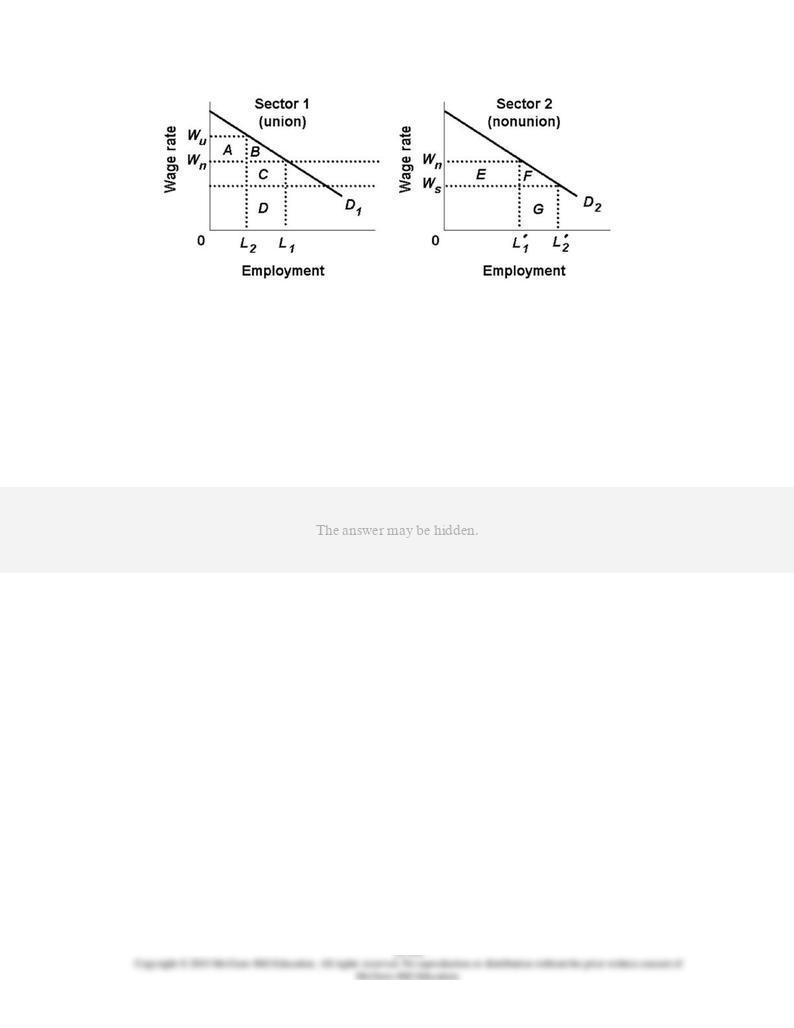
217.
Assumptions: These two graphs show two sectors of the labor market for a particular kind
of labor. Relevant product markets are competitive. The two labor demand curves are
identical and initially the quantities of labor employed in the two sectors are
L
1 and
L'
1 and
the wage rate in each sector is
Wn
.
Refer to the diagrams and assumptions. The change in employment in sector 1 to which a
Wn
to
Wu
union wage increase gives rise will cause output in that sector to:
AACSB: Reflective Thinking
Blooms: Analyze
Difficulty: 3 Hard
Learning Objective: 15-09 (Appendix) Relate who belongs to U.S. unions; the basics of collective bargaining; and the
economic effects of unions.
Topic: Economic effects of unions
Type: Graph

218.
Assumptions: These two graphs show two sectors of the labor market for a particular kind
of labor. Relevant product markets are competitive. The two labor demand curves are
identical and initially the quantities of labor employed in the two sectors are
L
1 and
L'
1 and
the wage rate in each sector is
Wn
.
Refer to the diagrams and assumptions. If all the workers who lose their jobs in the union
sector because of a
Wn
to
Wu
union wage increase are reemployed in nonunion sector 2,
output in that sector will:
AACSB: Reflective Thinking
Blooms: Analyze
Difficulty: 3 Hard
Learning Objective: 15-09 (Appendix) Relate who belongs to U.S. unions; the basics of collective bargaining; and the
economic effects of unions.
Topic: Economic effects of unions
Type: Graph

219.
Assumptions: These two graphs show two sectors of the labor market for a particular kind
of labor. Relevant product markets are competitive. The two labor demand curves are
identical and initially the quantities of labor employed in the two sectors are
L
1 and
L'
1 and
the wage rate in each sector is
Wn
.
Refer to the diagrams and assumptions. This analysis suggests that a union wage
advantage of
Wu
minus
Ws
causes a net efficiency:
AACSB: Reflective Thinking
Blooms: Analyze
Difficulty: 3 Hard
Learning Objective: 15-09 (Appendix) Relate who belongs to U.S. unions; the basics of collective bargaining; and the
economic effects of unions.
Topic: Economic effects of unions
Type: Graph

220.
Empirical studies suggest that the efficiency loss associated with the misallocation of
labor caused by the union wage advantage is:
AACSB: Reflective Thinking
Accessibility: Keyboard Navigation
Blooms: Remember
Difficulty: 1 Easy
Learning Objective: 15-09 (Appendix) Relate who belongs to U.S. unions; the basics of collective bargaining; and the
economic effects of unions.
Topic: Economic effects of unions
221.
Which of the following statements is
correct
?
AACSB: Reflective Thinking
Accessibility: Keyboard Navigation
Blooms: Remember
Difficulty: 1 Easy
Learning Objective: 15-09 (Appendix) Relate who belongs to U.S. unions; the basics of collective bargaining; and the
economic effects of unions.
Topic: Economic effects of unions

222.
Which one of the following research findings is most consistent with the hypothesis that
unions increase productivity?
AACSB: Reflective Thinking
Accessibility: Keyboard Navigation
Blooms: Understand
Difficulty: 2 Medium
Learning Objective: 15-09 (Appendix) Relate who belongs to U.S. unions; the basics of collective bargaining; and the
economic effects of unions.
Topic: Economic effects of unions
True / False Questions
223.
Since the mid-1950s, union membership has declined as a percentage of employed wage
and salary workers.
AACSB: Reflective Thinking
Accessibility: Keyboard Navigation
Blooms: Remember
Difficulty: 1 Easy
Learning Objective: 15-09 (Appendix) Relate who belongs to U.S. unions; the basics of collective bargaining; and the
economic effects of unions.
Topic: Decline of unionism
Topic: Union membership

224.
The rate of unionization is substantially higher for protective service workers than for sales
workers.
AACSB: Reflective Thinking
Accessibility: Keyboard Navigation
Blooms: Remember
Difficulty: 1 Easy
Learning Objective: 15-09 (Appendix) Relate who belongs to U.S. unions; the basics of collective bargaining; and the
economic effects of unions.
Topic: Decline of unionism
Topic: Union membership
225.
Unions prefer agency shops to open shops.
AACSB: Reflective Thinking
Accessibility: Keyboard Navigation
Blooms: Remember
Difficulty: 1 Easy
Learning Objective: 15-09 (Appendix) Relate who belongs to U.S. unions; the basics of collective bargaining; and the
economic effects of unions.
Topic: Collective bargaining
226.
There is no evidence that unions are able to increase wage rates above those that the
market would otherwise provide.
AACSB: Reflective Thinking
Accessibility: Keyboard Navigation
Blooms: Remember
Difficulty: 1 Easy
Learning Objective: 15-09 (Appendix) Relate who belongs to U.S. unions; the basics of collective bargaining; and the
economic effects of unions.
Topic: Economic effects of unions
227.
Union workers have higher rates of job turnover than do nonunion workers.
AACSB: Reflective Thinking

Accessibility: Keyboard Navigation
Blooms: Remember
Difficulty: 1 Easy
Learning Objective: 15-09 (Appendix) Relate who belongs to U.S. unions; the basics of collective bargaining; and the
economic effects of unions.
Topic: Economic effects of unions
228.
Right-to-work laws prohibit the formation of labor unions.
AACSB: Reflective Thinking
Accessibility: Keyboard Navigation
Blooms: Remember
Difficulty: 1 Easy
Learning Objective: 15-09 (Appendix) Relate who belongs to U.S. unions; the basics of collective bargaining; and the
economic effects of unions.
Topic: Collective bargaining
229.
The presence of an agency shop requires all workers to join the union within the first 30
days of employment.
AACSB: Analytic
Accessibility: Keyboard Navigation
Blooms: Remember
Difficulty: 1 Easy
Learning Objective: 15-09 (Appendix) Relate who belongs to U.S. unions; the basics of collective bargaining; and the
economic effects of unions.
Topic: Collective bargaining
230.
Six of the 50 states account for approximately half of all union members in the United
States.
AACSB: Reflective Thinking
Accessibility: Keyboard Navigation
Blooms: Remember
Difficulty: 1 Easy
Learning Objective: 15-09 (Appendix) Relate who belongs to U.S. unions; the basics of collective bargaining; and the
economic effects of unions.
Topic: Decline of unionism
Topic: Union membership

231.
African Americans have higher unionization rates than whites.
AACSB: Reflective Thinking
Accessibility: Keyboard Navigation
Blooms: Remember
Difficulty: 1 Easy
Learning Objective: 15-09 (Appendix) Relate who belongs to U.S. unions; the basics of collective bargaining; and the
economic effects of unions.
Topic: Decline of unionism
Topic: Union membership
232.
In 2011, approximately 5 percent of all work time lost was due to work stoppages.
AACSB: Reflective Thinking
Accessibility: Keyboard Navigation
Blooms: Remember
Difficulty: 1 Easy
Learning Objective: 15-09 (Appendix) Relate who belongs to U.S. unions; the basics of collective bargaining; and the
economic effects of unions.
Topic: Economic effects of unions